Metabolite Production in Endophytes
SPANGENBERG; German Carlos ; et al.
U.S. patent application number 16/324983 was filed with the patent office on 2020-08-27 for metabolite production in endophytes. This patent application is currently assigned to Agriculture Victoria Services Pty Ltd. The applicant listed for this patent is Agriculture Victoria Services Pty Ltd. Invention is credited to Natasha Denise BROHIER, Sophie Elizabeth DAVIDSON, Kathryn Michaela GUTHRIDGE, Inoka Kumari HETTIARACHCHIGE, Emma Jane Isobel LUDLOW, Ross MANN, Simone Jane ROCHFORT, Timothy Ivor SAWBRIDGE, German Carlos SPANGENBERG, Simone VASSILIADIS.
| Application Number | 20200270314 16/324983 |
| Document ID | / |
| Family ID | 1000004004189 |
| Filed Date | 2020-08-27 |

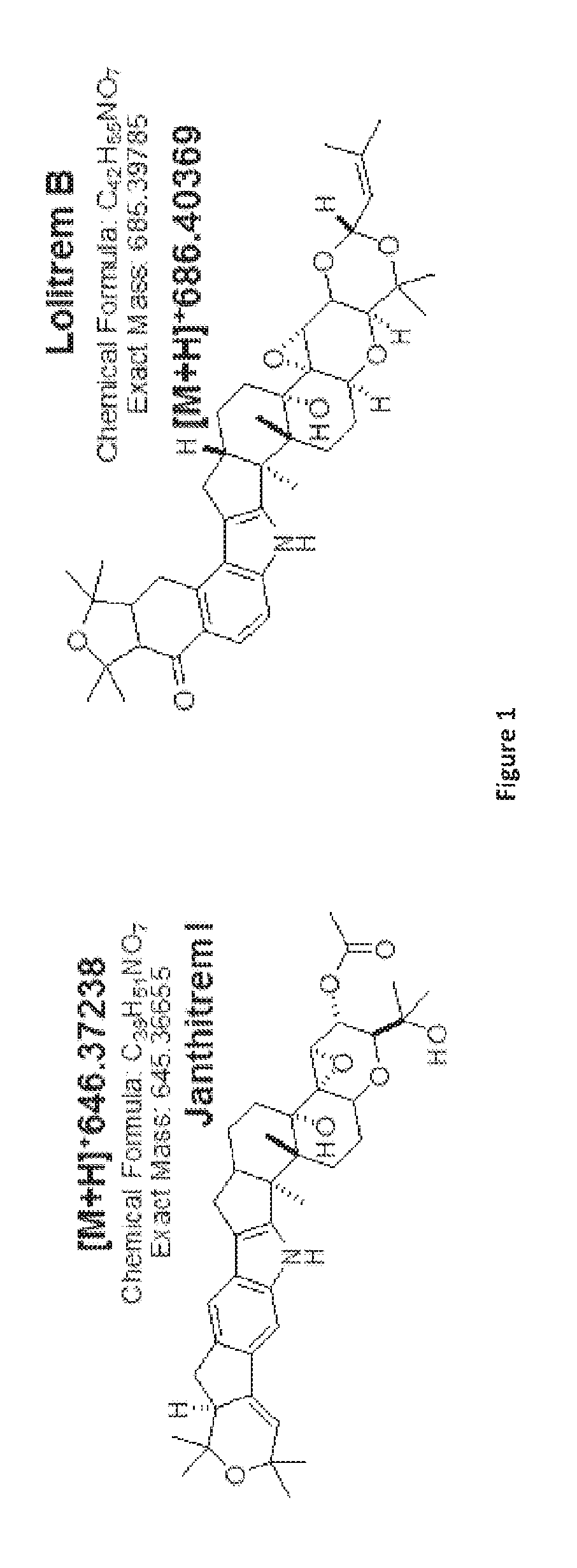

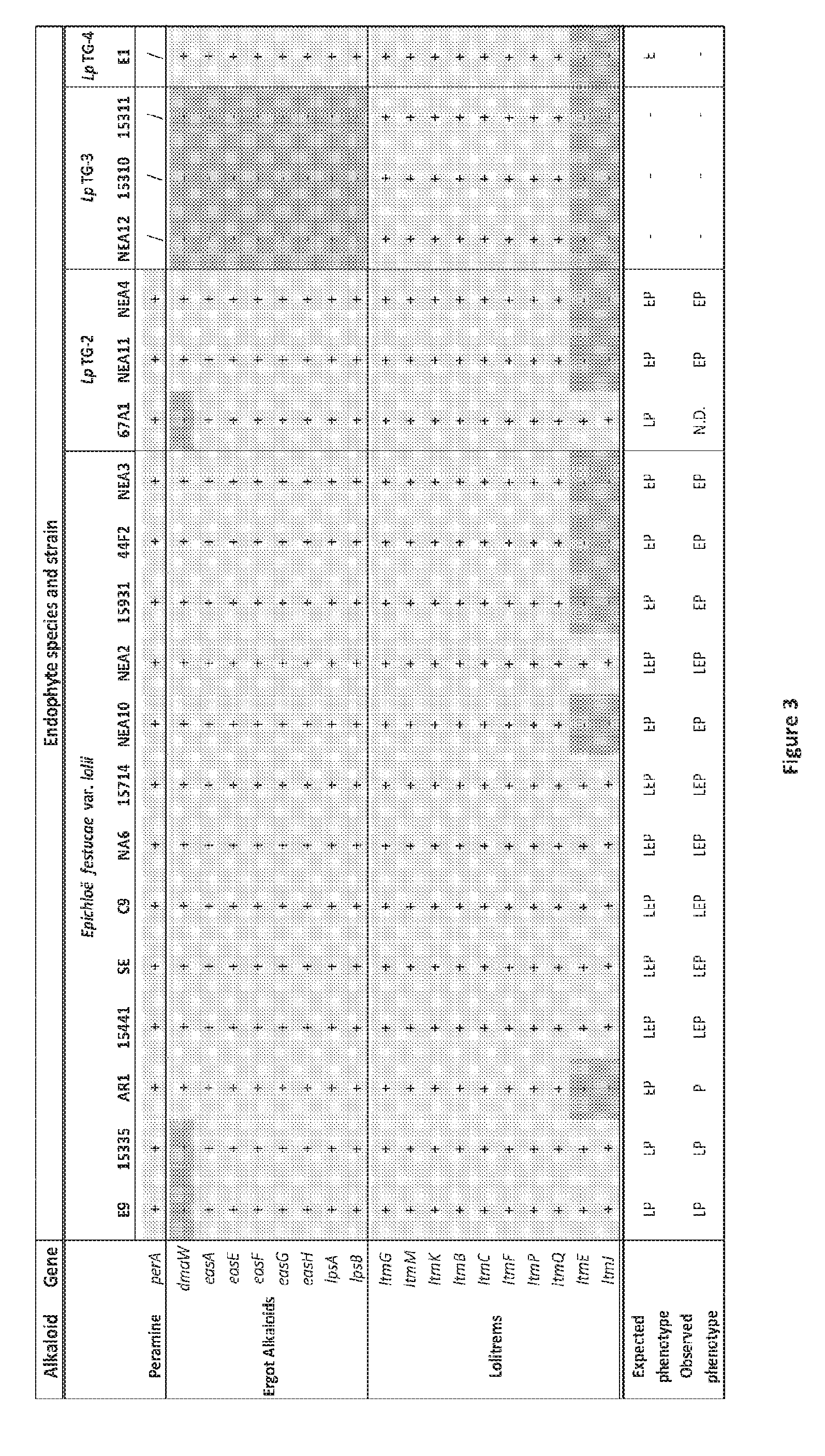
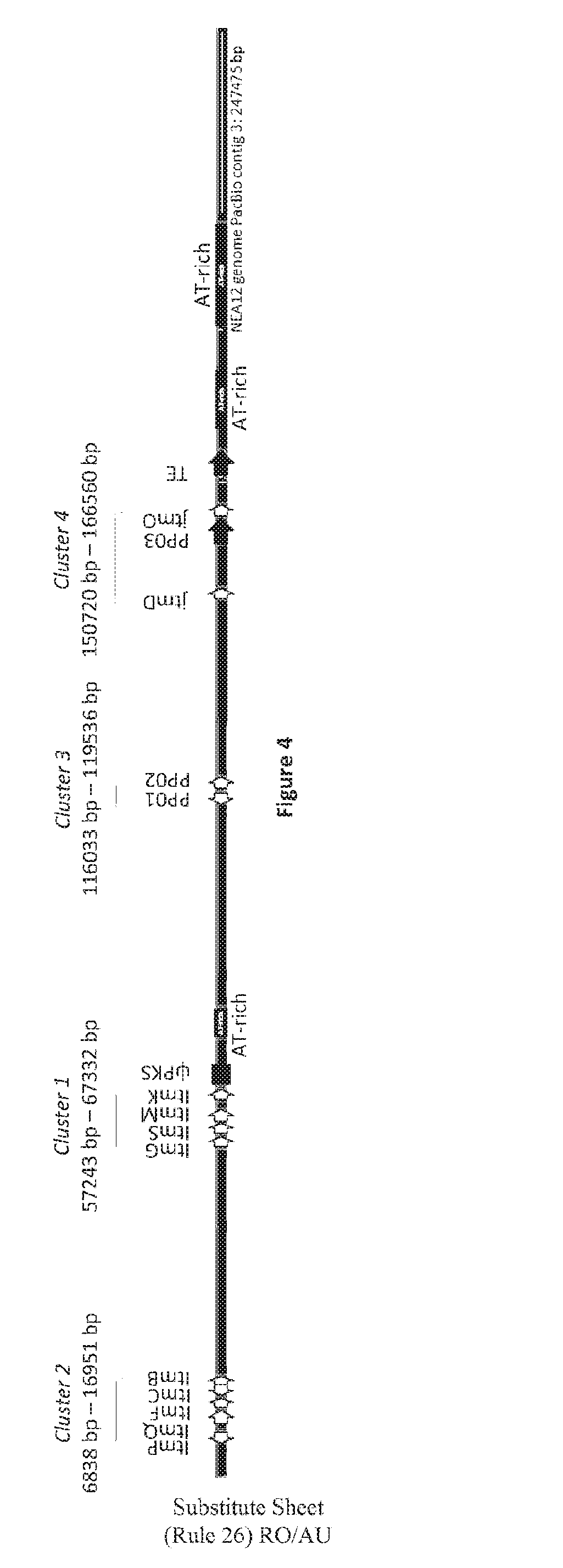
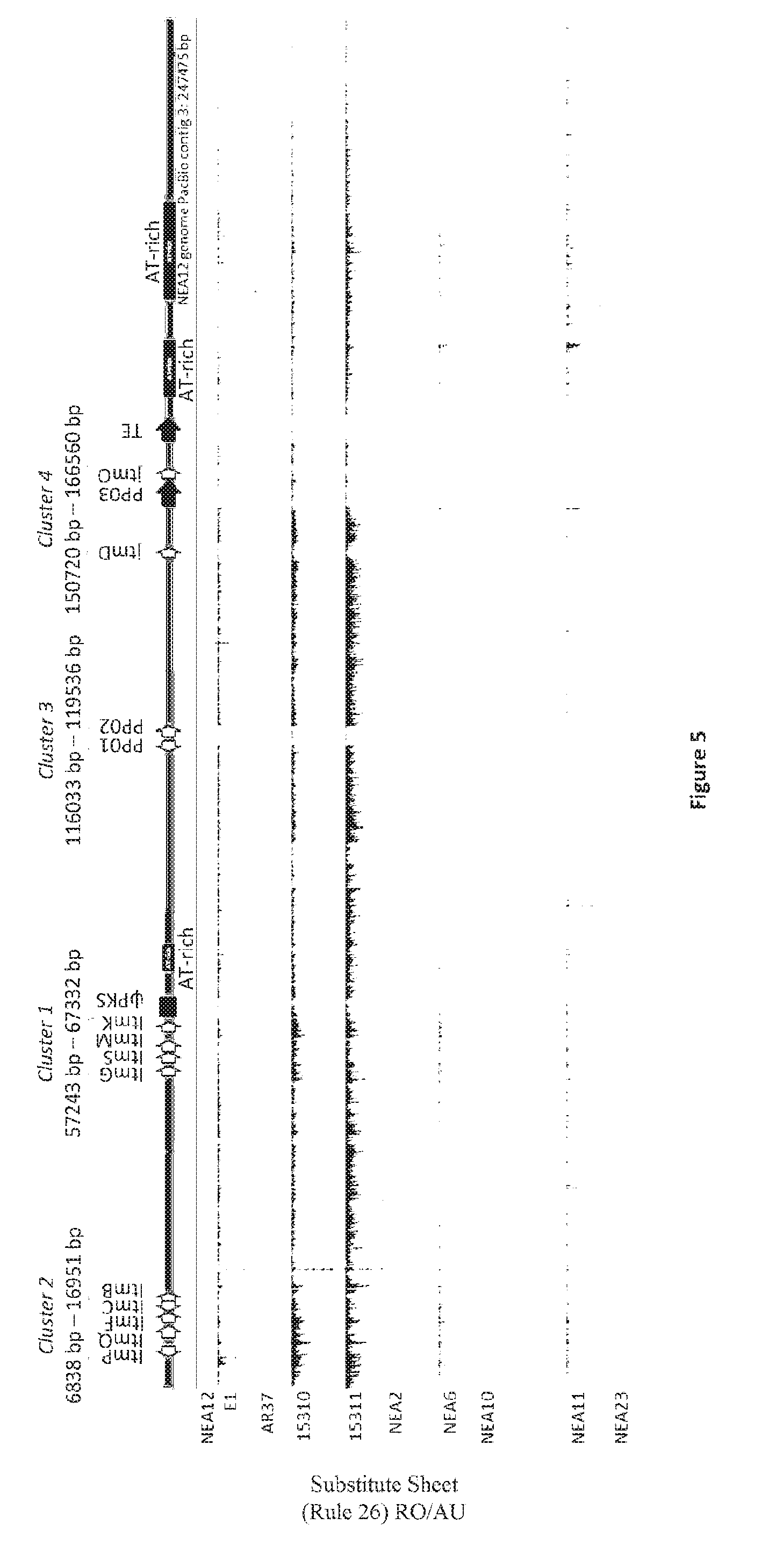
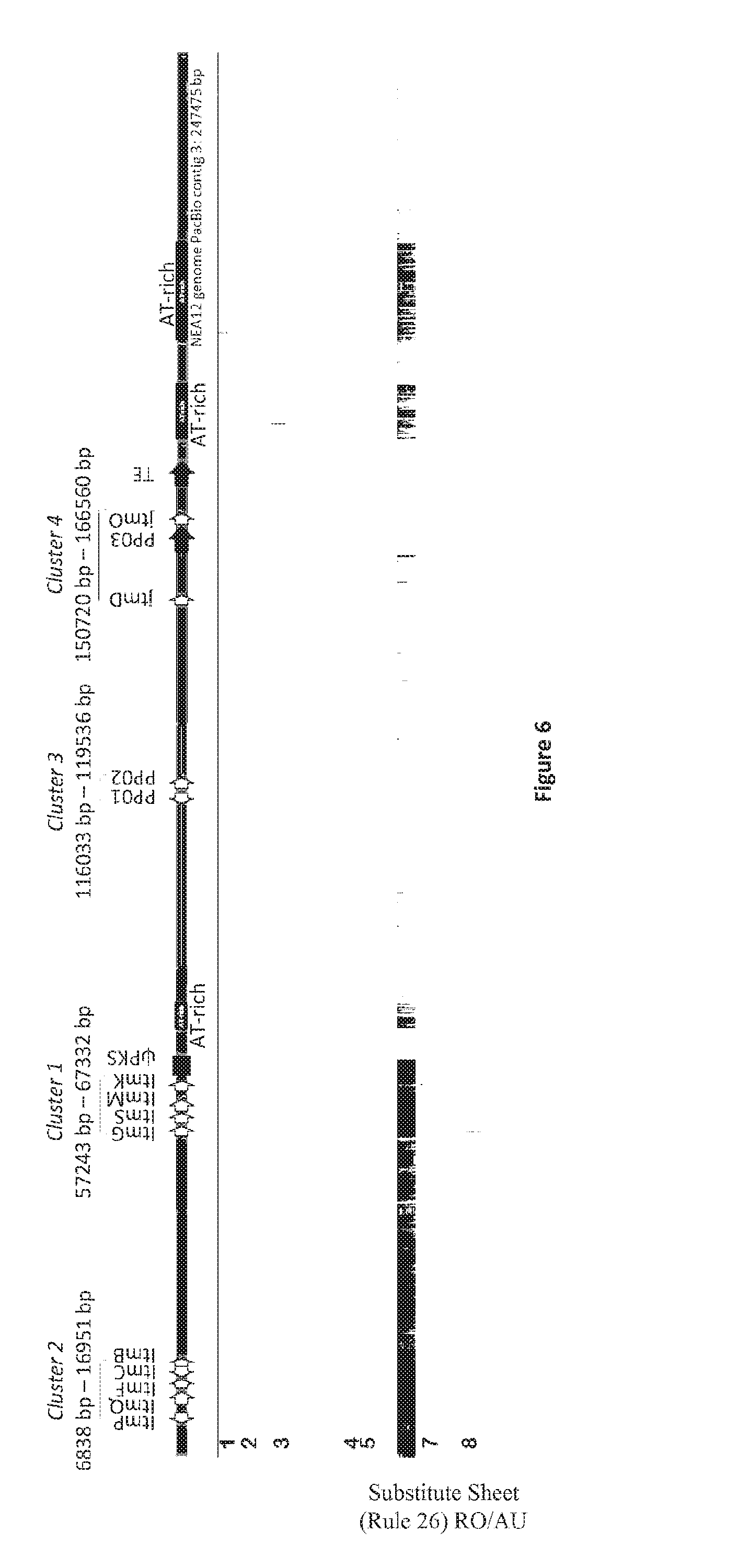
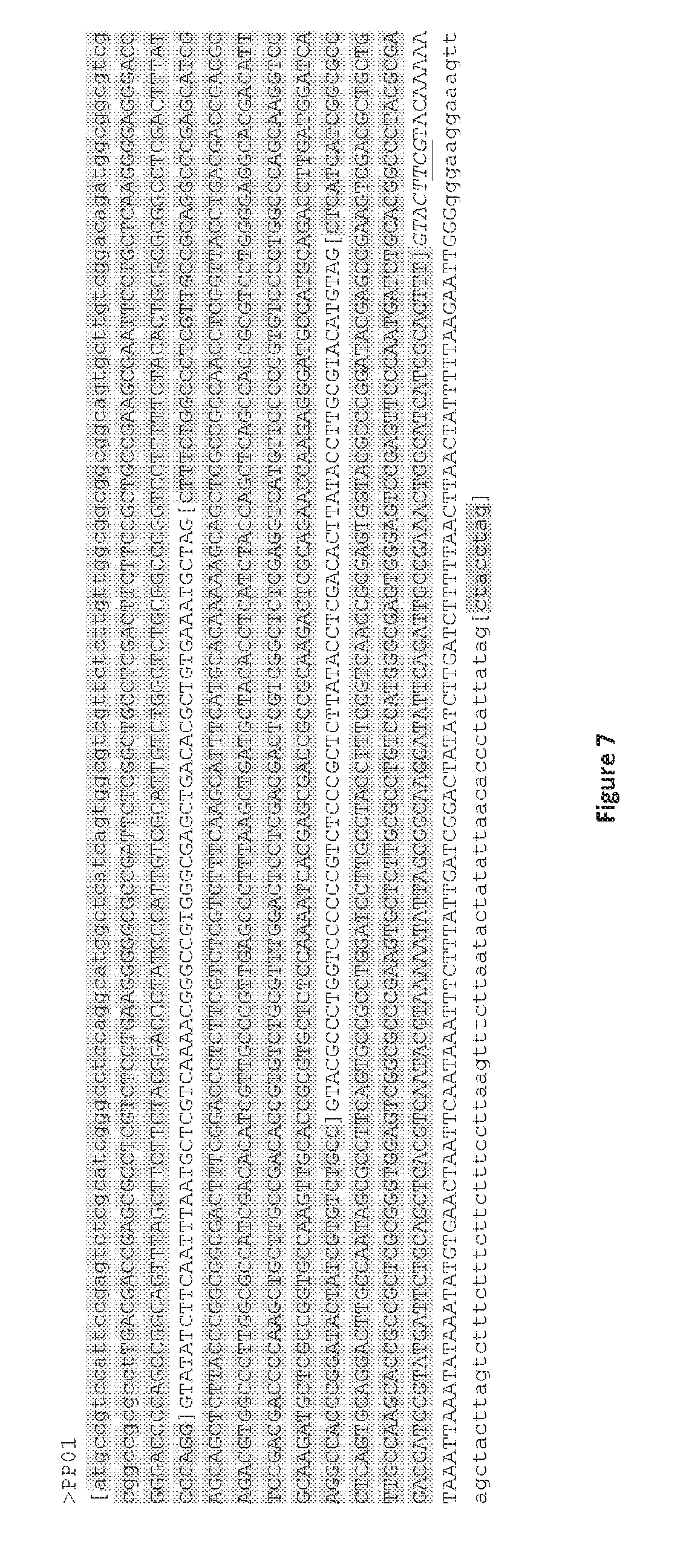
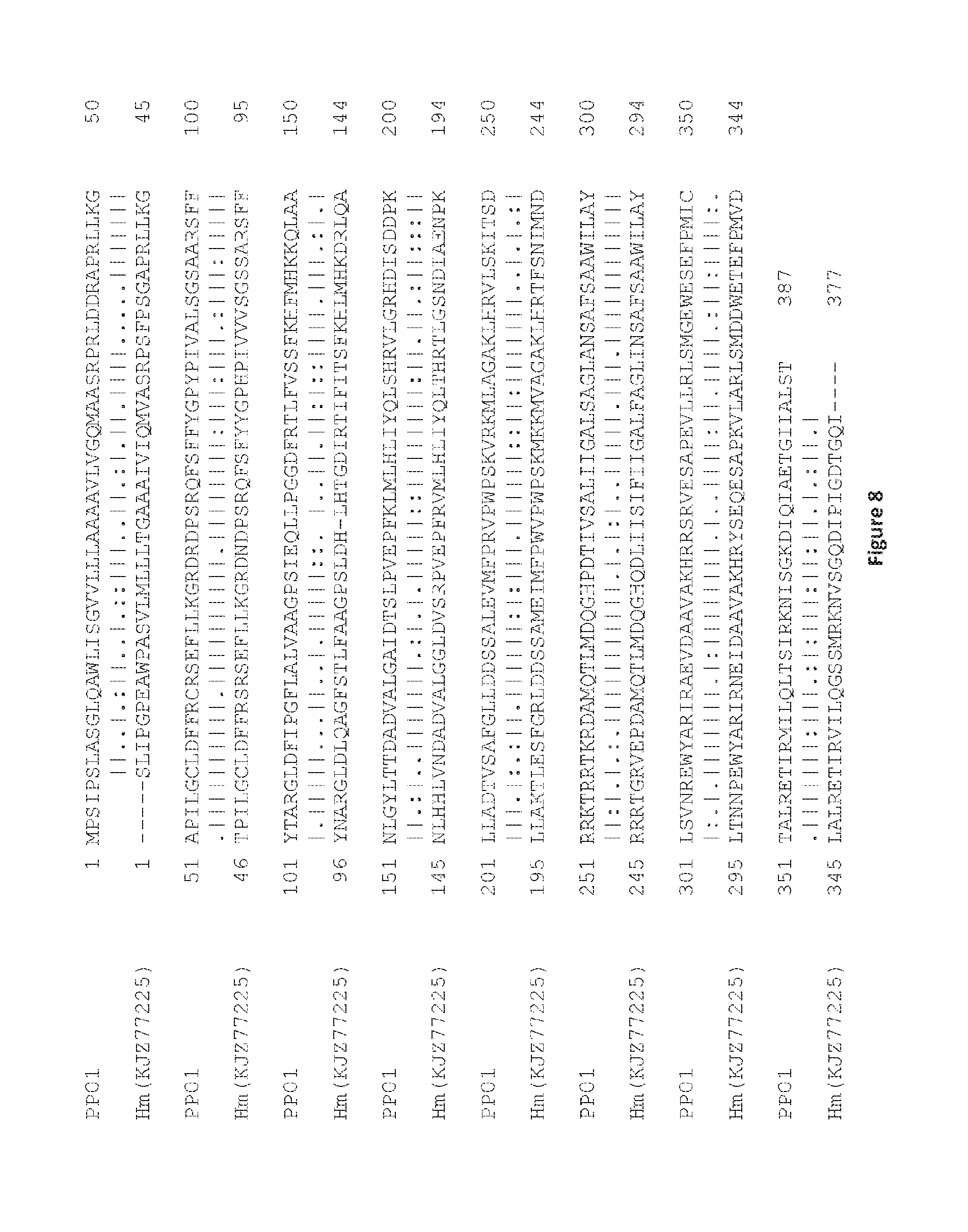
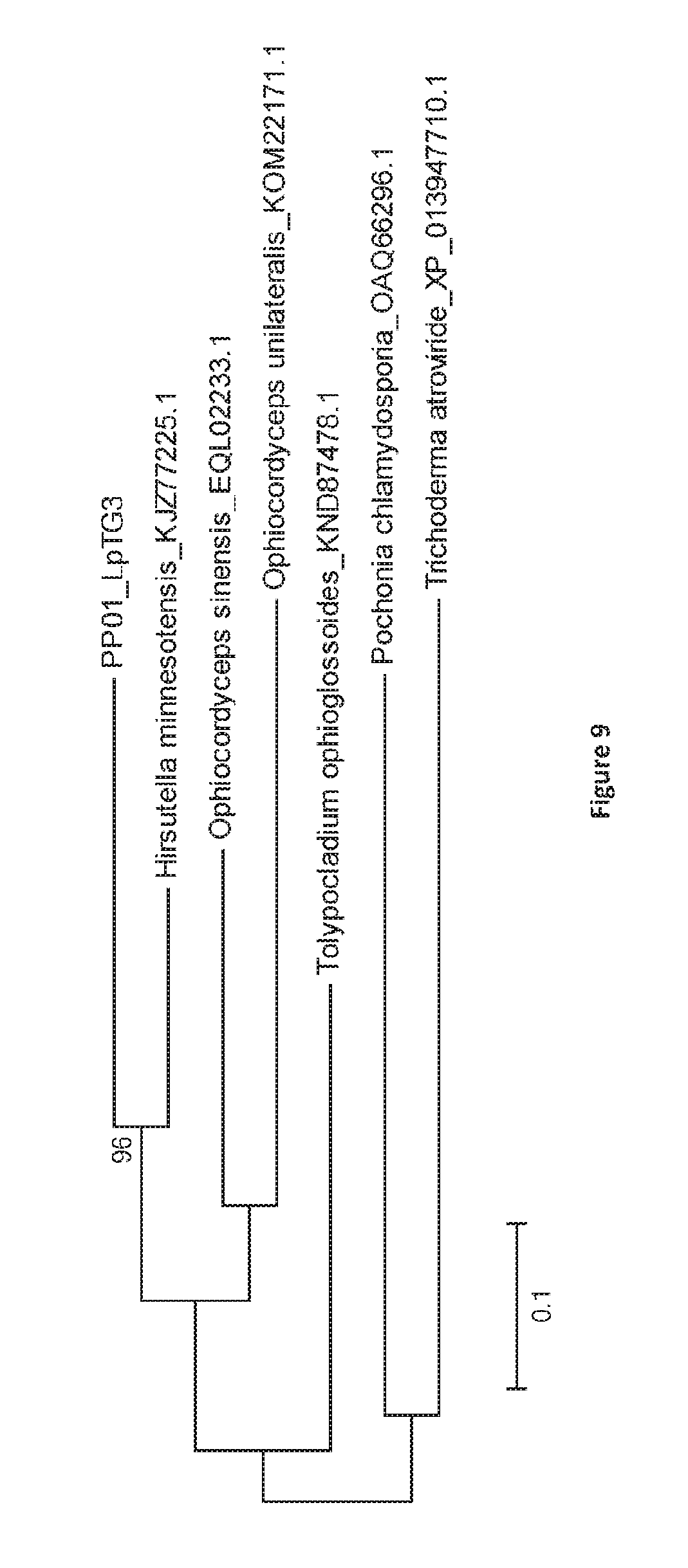

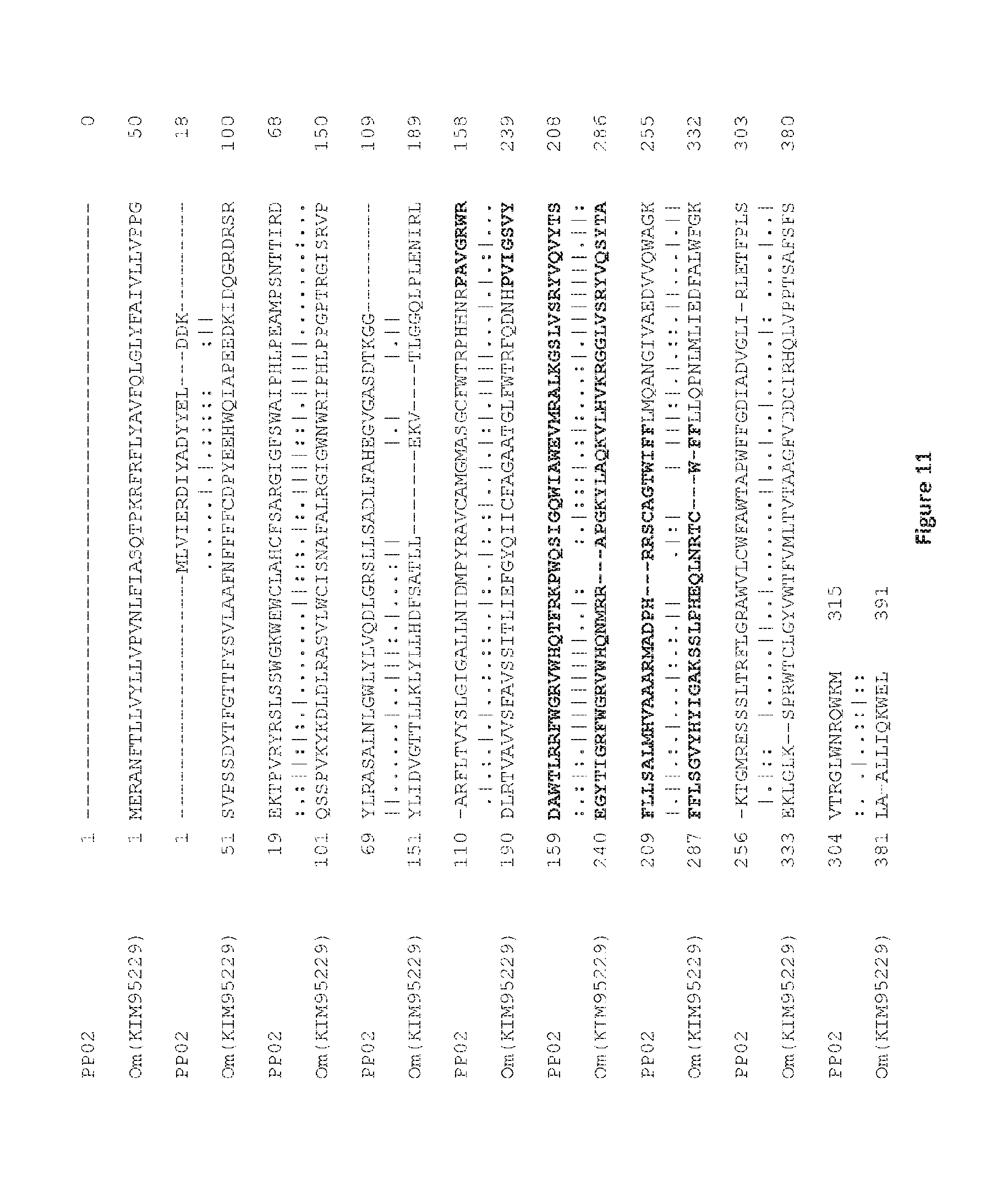
View All Diagrams
| United States Patent Application | 20200270314 |
| Kind Code | A1 |
| SPANGENBERG; German Carlos ; et al. | August 27, 2020 |
Metabolite Production in Endophytes
Abstract
The present invention relates to nucleic acids encoding amino acid sequences for the biosynthesis of janthitrem in janthitrem producing endophytes. The present invention also relates to constructs and vectors including such nucleic acids, and related polypeptides, regulatory elements and methods.
| Inventors: | SPANGENBERG; German Carlos; (Bundoora, AU) ; GUTHRIDGE; Kathryn Michaela; (Glenroy, AU) ; MANN; Ross; (Wendouree, AU) ; SAWBRIDGE; Timothy Ivor; (Coburg, AU) ; DAVIDSON; Sophie Elizabeth; (Heidelberg Heights, AU) ; VASSILIADIS; Simone; (Essendon, AU) ; HETTIARACHCHIGE; Inoka Kumari; (Kingsbury, AU) ; ROCHFORT; Simone Jane; (Reservoir, AU) ; LUDLOW; Emma Jane Isobel; (Viewbank, AU) ; BROHIER; Natasha Denise; (Northcote, AU) | ||||||||||
| Applicant: |
|
||||||||||
|---|---|---|---|---|---|---|---|---|---|---|---|
| Assignee: | Agriculture Victoria Services Pty
Ltd Attwood, VIC AU |
||||||||||
| Family ID: | 1000004004189 | ||||||||||
| Appl. No.: | 16/324983 | ||||||||||
| Filed: | August 11, 2017 | ||||||||||
| PCT Filed: | August 11, 2017 | ||||||||||
| PCT NO: | PCT/AU2017/050847 | ||||||||||
| 371 Date: | February 12, 2019 |
| Current U.S. Class: | 1/1 |
| Current CPC Class: | C12N 15/80 20130101; C07K 14/37 20130101; A01H 17/00 20130101 |
| International Class: | C07K 14/37 20060101 C07K014/37; C12N 15/80 20060101 C12N015/80; A01H 17/00 20060101 A01H017/00 |
Foreign Application Data
| Date | Code | Application Number |
|---|---|---|
| Aug 12, 2016 | AU | 2016903172 |
Claims
1-16. (canceled)
17. A substantially purified or isolated nucleic acid or nucleic acid fragment encoding a janthitrem biosynthesis polypeptide, or complementary or antisense to a sequence encoding a janthitrem biosynthesis polypeptide, said nucleic acid or nucleic acid fragment including a nucleotide sequence selected from the group consisting of (a) sequences shown in FIGS. 7, 10, 13 and 16 (Sequence ID Nos 1, 2, 5, 6, 9, 10, 13 and 14); (b) complements of the sequences in (a); (c) sequences antisense to the sequences recited in (a) and (b); and (d) functionally active fragments and variants of the sequences recited in (a), (b) and (c) having at least approximately 80% identity to the relevant part of the sequences recited in (a), (b) and (c) and having a size of at least 20 nucleotides.
18. A nucleic acid or nucleic acid fragment according to claim 17, wherein said functionally active fragments and variants have at least approximately 95% identity to the relevant part of the sequences recited in (a), (b) and (c) and have a size of at least 200 nucleotides.
19. A nucleic acid or nucleic acid fragment according to claim 18, wherein said nucleic acid or nucleic acid fragment includes a nucleotide sequence shown in FIGS. 7, 10, 13 and 16.
20. A construct including a nucleic acid or nucleic acid fragment according to claim 17.
21. A construct according to claim 20, wherein said construct is a vector further including a promoter and a terminator, said promoter, nucleic acid or nucleic acid fragment and terminator being operatively linked.
22. A method of modifying janthitrem biosynthesis in an endophyte, said method including introducing into said endophyte an effective amount of a substantially purified or isolated nucleic acid or nucleic acid fragment encoding a janthitrem biosynthesis polypeptide, or complementary or antisense to a sequence encoding a janthitrem biosynthesis polypeptide, said nucleic acid or nucleic acid fragment including a nucleotide sequence selected from the group consisting of (a) sequences shown in FIGS. 7, 10, 13 and 16 (Sequence ID Nos 1, 2, 5, 6, 9, 10, 13 and 14), (b) complements of the sequences in (a), (c) sequences antisense to the sequences recited in (a) and (b), and (d) functionally active fragments and variants of the sequences recited in (a), (b) and (c) having at least approximately 80% identity to the relevant part of the sequences recited in (a), (b) and (c) and having a size of at least 20 nucleotides or a construct including the substantially purified or isolated nucleic acid or nucleic acid fragment.
23. A plant inoculated with an endophyte, said plant comprising an endophyte-free host plant stably infected with said endophyte, wherein said endophyte has introduced into it an effective amount of a substantially purified or isolated nucleic acid or nucleic acid fragment encoding a janthitrem biosynthesis polypeptide, or complementary or antisense to a sequence encoding a janthitrem biosynthesis polypeptide, said nucleic acid or nucleic acid fragment including a nucleotide sequence selected from the group consisting of (a) sequences shown in FIGS. 7, 10, 13 and 16 (Sequence ID Nos 1, 2, 5, 6, 9, 10, 13 and 14), (b) complements of the sequences in (a), (c) sequences antisense to the sequences recited in (a) and (b), and (d) functionally active fragments and variants of the sequences recited in (a), (b) and (c) having at least approximately 80% identity to the relevant part of the sequences recited in (a), (b) and (c) and having a size of at least 20 nucleotides or a construct including the substantially purified or isolated nucleic acid or nucleic acid fragment.
24. A plant, plant seed or other plant part derived from a plant according to claim 23 and stably infected with the endophyte.
25. Use of an endophyte to produce a plant stably infected with said endophyte, wherein said endophyte has introduced into it an effective amount of a substantially purified or isolated nucleic acid or nucleic acid fragment encoding a janthitrem biosynthesis polypeptide, or complementary or antisense to a sequence encoding a janthitrem biosynthesis polypeptide, said nucleic acid or nucleic acid fragment including a nucleotide sequence selected from the group consisting of (a) sequences shown in FIGS. 7, 10, 13 and 16 (Sequence ID Nos 1, 2, 5, 6, 9, 10, 13 and 14), (b) complements of the sequences in (a), (c) sequences antisense to the sequences recited in (a) and (b), and (d) functionally active fragments and variants of the sequences recited in (a), (b) and (c) having at least approximately 80% identity to the relevant part of the sequences recited in (a), (b) and (c) and having a size of at least 20 nucleotides or a construct including the substantially purified or isolated nucleic acid or nucleic acid fragment.
26. A substantially purified or isolated polypeptide involved in janthitrem biosynthesis in an endophyte.
27. A polypeptide according to claim 26, wherein said endophyte is from the taxa LPTG-3 or LPTG-4.
28. A substantially purified or isolated janthitrem biosynthesis polypeptide including an amino acid sequence selected from the group consisting of (a) sequences shown in FIGS. 8, 11, 14 and 17 (Sequence ID Nos 3, 4, 7, 8 11, 12, 15 and 16); and (b) functionally active fragments and variants of the sequences recited in (a) having at least approximately 80% identity with the relevant part of the sequences recited in (a) and having a size of at least 20 amino acids.
29. A polypeptide according to claim 28, wherein said functionally active fragments and variants have at least approximately 95% identity to the relevant part of the sequences recited in (a), (b) and (c) and have a size of at least 100 amino acids.
Description
FIELD OF THE INVENTION
[0001] The present invention relates to the biosynthesis of janthitrem compounds. In particular, the invention relates to genes encoding enzymes responsible for the synthesis of janthitrem and related constructs, vectors and methods.
BACKGROUND OF THE INVENTION
[0002] Endophytes reside in the tissues of living plants and offer a particularly diverse source of novel compounds and genes that may provide important benefits to society, and in particular to agriculture. Endophytes often form mutualistic relationships with their hosts, with the endophyte conferring increased fitness to the host, often through the production of defence compounds. At the same time, the host plant offers the benefits of a protected environment and nutriment to the endophyte. The plant provides nutrients for the endophyte and a means of dissemination through the seed. The endophyte protects the host from biotic (e.g. insect and mammalian herbivory) and abiotic stress (e.g. drought).
[0003] Important forage grasses perennial ryegrass and tall fescue are commonly found in association with fungal endophytes. Both beneficial and detrimental agronomic properties result from the association, including improved tolerance to water and nutrient stress and resistance to insect pests. Insect resistance is provided by specific metabolites produced by the endophyte, in particular loline alkaloids and peramine. Other metabolites produced by the endophyte, lolitrems and ergot alkaloids, are toxic to grazing animals and reduce herbivore feeding. These compounds can accumulate to high levels in plants where they act as potent feeding deterrents against a range of insect pests.
[0004] Janthitrems are a class of indole diterpenes, and are produced by a subgroup of endophytes. In 1980, an outbreak of ryegrass staggers syndrome led to the first identification of janthitrem alkaloids (Gallagher et al. 1980) Recent discoveries highlight the diversity of janthitrems; P. janthinellum isolates from Australia and New Zealand produce a wide range of janthitrems (janthitrem B, C, D, E, F and G).
[0005] Janthitrems are a class of indole diterpenes with structural similarity to lolitrem B (FIG. 1). The epoxy-janthitrems are a group of five compounds: three further structures isolated alongside epoxy-janthitrem I were assigned epoxy-janthitrem II [10-deacetyl-10,34-(3-methylbut-2-enyl acetal)]; epoxy-janthitrem III [10-deacetyl-34-O-(3-methylbut-2-enyl)]; and epoxy-janthitrem IV [34-O-(3-methylbut-2-enyl)], each of which are derivatives of epoxy-janthitrem I on the basis of LC-MS analysis. Epoxy-janthitrem I is the major janthitrem alkaloid produced by perennial ryegrass endophytes.
[0006] The presence of janthitrems in perennial ryegrass pastures provides superior protection against a wide range of important pasture pests. Recent discoveries have indicated that janthitrems can be tremorgenic in nature, similar to lolitrem B. Lolitrem B is known to be the main causative agent in ryegrass staggers. This is a condition in which animals grazing on endophyte infected pastures develop ataxia, tremors, and hypersensitivity to external stimuli. Like lolitrem B, janthitrem B can induce a tremorgenic response. Recent bioactivity studies of janthitrems A and B from P. janthinellum found these two compounds to be tremorgenic to mice and to have anti-insect activity to porina (Wiseana cervinata) larvae (Babu, 2009). Further, when purified, Epichloe endophyte derived janthitrems have been observed to exhibit bioprotective properties that provide an advantage to pasture.
[0007] Despite these useful properties, janthitrem alkaloids are not well understood when compared to other alkaloid groups synthesised by endophytes. There is an increasing need to further understand janthitrems and their biosynthesis, as this would provide information useful in manipulating janthitrem production.
[0008] It is an object of the present invention to overcome, or at least alleviate, one or more of the difficulties or deficiencies associated with the prior art.
SUMMARY OF THE INVENTION
[0009] In one aspect, the present invention provides a substantially purified or isolated nucleic acid or nucleic acid fragment encoding a gene involved in the biosynthesis of a janthitrem in an endophyte.
[0010] By `nucleic acid` is meant a chain of nucleotides capable of genetic information. The term generally refers to genes or functionally active fragments or variants thereof and or other sequences in the genome of the organism that influence its phenotype. The term `nucleic acid` includes DNA (such as cDNA or genomic DNA) and RNA (such as mRNA or microRNA) that is single- or double stranded, optionally containing synthetic, non-natural or altered nucleotide bases, synthetic nucleic acids and combinations thereof.
[0011] Nucleic acids according to the invention may be full-length genes or part thereof, and are also referred to as "nucleic acid fragments" and "nucleotide sequences" in this specification. For convenience, the expression "nucleic acid or nucleic acid fragment" is used to cover all of these.
[0012] By `substantially purified` is meant that the nucleic acid is free of the genes, which, in the naturally-occurring genome of the organism from which the nucleic acid of the invention is derived, flank the nucleic acid. The term therefore includes, for example, a nucleic acid which is incorporated into a vector; into an autonomously replicating plasmid or virus; or into the genomic DNA of a prokaryote or eukaryote; or which exists as a separate molecule (e.g. a cDNA or a genomic or cDNA fragment produced by PCR or restriction endonuclease digestion) independent of other sequences. It also includes a nucleic acid which is part of a hybrid gene encoding additional polypeptide sequence. Preferably, the substantially purified nucleic acid is 90%, more preferably 95%, even more preferably 98% pure.
[0013] The term "isolated" means that the material is removed from its original environment (e.g. the natural environment if it is naturally occurring). For example, a naturally occurring nucleic acid present in a living plant is not isolated, but the same nucleic acid separated from some or all of the coexisting materials in the natural system, is isolated. Such nucleic acids could be part of a vector and/or such nucleic acids could be part of a composition, and still be isolated in that such a vector or composition is not part of its natural environment.
[0014] In a preferred embodiment of this aspect of the invention, the janthitrem producing endophyte is an Epichloe endophyte, in a more preferred embodiment the endophyte is from the taxa LpTG-3 or LpTG-4, and in an even more preferred embodiment the endophyte is selected from the group consisting of NEA12, AR37, 15310, 15311 and E1.
[0015] In a second aspect of the present invention there is provided substantially purified or isolated nucleic acid or nucleic acid fragment encoding a janthitrem biosynthesis polypeptide, or complementary or antisense to a sequence encoding a janthitrem biosynthesis polypeptide, said nucleic acid or nucleic acid fragment including a nucleotide sequence selected from the group consisting of (a) sequences shown in FIGS. 7, 10, 13 and 16 hereto (Sequence ID Nos 1, 2, 5, 6, 9, 10, 13 and 14);; (b) complements of the sequences recited in (a); (c) sequences antisense to the sequences recited in (a) and (b); and (d) functionally active fragments and variants of the sequences recited in (a), (b) and (c) having at least approximately 80% identity to the relevant part of the sequences recited in (a), (b) and (c) and having a size of at least 20 nucleotides.
[0016] The present invention encompasses functionally active fragments and variants of the nucleic acids of the present invention. By `functionally active` in relation to the nucleic acid is meant that the fragment or variant (such as an analogue, derivative or mutant) is capable of modulating janthitrem biosynthesis. Such variants include naturally occurring allelic variants and non-naturally occurring variants. Additions, deletions, substitutions and derivatizations of one or more of the nucleotides are contemplated so long as the modifications do not result in loss of functional activity of the fragment or variant. Preferably the functionally active fragment or variant has at least approximately 80% identity to the relevant part of the above mentioned sequence to which the fragment or variant corresponds, more preferably at least approximately 90% identity, even more preferably at least approximately 95% identity, most preferably at least approximately 98% identity. Such functionally active variants and fragments include, for example, those having conservative nucleic acid changes.
[0017] Preferably the fragment has a size of at least 20 nucleotides, more preferably at least 50 nucleotides, more preferably at least 100 nucleotides, more preferably at least 200 nucleotides, more preferably at least 500 nucleotides.
[0018] By `conservative nucleic acid changes` is meant nucleic acid substitutions that result in conservation of the amino acid in the encoded protein, due to the degeneracy of the genetic code. Such functionally active variants and fragments also include, for example, those having nucleic acid changes which result in conservative amino acid substitutions of one or more residues in the corresponding amino acid sequence.
[0019] By `conservative amino acid substitutions` is meant the substitution of an amino acid by another one of the same class, the classes being as follows: [0020] Nonpolar: Ala, Val, Leu, Ile, Pro, Met Phe, Trp [0021] Uncharged polar: Gly, Ser, Thr, Cys, Tyr, Asn, Gln [0022] Acidic: Asp, Glu [0023] Basic: Lys, Arg, His
[0024] Other conservative amino acid substitutions may also be made as follows: [0025] Aromatic: Phe, Tyr, His [0026] Proton Donor: Asn, Gln, Lys, Arg, His, Trp [0027] Proton Acceptor: Glu, Asp, Thr, Ser, Tyr, Asn, Gln
[0028] In a further aspect of the present invention, there is provided a genetic construct including a nucleic acid according to the present invention. In a preferred embodiment the genetic construct may include a chimeric sequence comprising a nucleic acid according to the present invention and a gene encoding a mediator or modulator janthitrem biosynthesis. Preferably, the gene encoding a mediator or modulator of janthitrem biosynthesis is exogenous, i.e. it does not naturally occur in combination with the nucleic acid according to the present invention.
[0029] The term "genetic construct" as used herein refers to an artificially assembled or isolated nucleic acid molecule which includes the gene of interest. Preferably the genetic construct is a recombinant nucleic acid molecule. In general a construct may include the gene or genes of interest, a marker gene which in some cases can also be the gene of interest and appropriate regulatory sequences. Preferably the marker gene is exogenous, i.e. it does not naturally occur in combination with the nucleic acid according to the present invention.
[0030] It should be appreciated that the inclusion of regulatory sequences in a construct is optional, for example, such sequences may not be required in situations where the regulatory sequences of a host cell are to be used. The term construct includes vectors but should not be seen as being limited thereto.
[0031] By a `chimeric sequence` is meant a hybrid produced by recombinant means through expression of a fusion gene including two or more linked nucleic acids which originally encoded separate proteins, or functionally active fragments or variants thereof.
[0032] By a `fusion gene` is meant that two or more nucleic acids are linked in such a way as to permit expression of the fusion protein, preferably as a translational fusion. This typically involves removal of the stop codon from a nucleic acid sequence coding for a first protein, then appending the nucleic acid sequence of a second protein in frame. The fusion gene is then expressed by a cell as a single protein. The protein may be engineered to include the full sequence of both original proteins, or a functionally active fragment or variant of either or both.
[0033] In a preferred embodiment, the genetic construct according to the present invention may be a vector.
[0034] The vector may be of any suitable type and may be viral or non-viral. The vector may be an expression vector. Such vectors include chromosomal, non-chromosomal and synthetic nucleic acid sequences, e.g. derivatives of plant viruses; bacterial plasmids; derivatives of the Ti plasmid from Agrobacterium tumefaciens; derivatives of the Ri plasmid from Agrobacterium rhizogenes; phage DNA; yeast artificial chromosomes; bacterial artificial chromosomes; binary bacterial artificial chromosomes; vectors derived from combinations of plasmids and phage DNA. However, any other vector may be used as long as it is replicable or integrative or viable in the target cell.
[0035] In a preferred embodiment of this aspect of the invention, the genetic construct may further include a promoter and a terminator; said promoter, gene and terminator being operatively linked.
[0036] By a `promoter` is meant a nucleic acid sequence sufficient to direct transcription of an operatively linked nucleic acid sequence.
[0037] By `operatively linked` is meant that the nucleic acid(s) and a regulatory sequence, such as a promoter, are linked in such a way as to permit expression of said nucleic acid under appropriate conditions, for example when appropriate molecules such as transcriptional activator proteins are bound to the regulatory sequence. Preferably an operatively linked promoter is upstream of the associated nucleic acid.
[0038] By `upstream` is meant in the 3'->5' direction along the nucleic acid.
[0039] The promoter and terminator may be of any suitable type and may be endogenous to the target cell or may be exogenous, provided that they are functional in the target cell. Preferably, the promoter and/or terminator is exogenous, i.e. it does not naturally occur in combination with the nucleic acid according to the present invention.
[0040] A variety of terminators which may be employed in the genetic constructs of the present invention are also well known to those skilled in the art. The terminator may be from the same gene as the promoter sequence or a different gene. Particularly suitable terminators are polyadenylation signals, such as the (CaMV) 35S polyA and other terminators from the nopaline synthase (nos) and the octopine synthase (ocs) genes.
[0041] The genetic construct, in addition to the promoter, the gene and the terminator, may include further elements necessary for expression of the nucleic acid, in different combinations, for example vector backbone, origin of replication (ori), multiple cloning sites, spacer sequences, enhancers, introns (such as the maize Ubiquitin Ubi intron), antibiotic resistance genes and other selectable marker genes [such as the neomycin phosphotransferase (nptll) gene, the hygromycin phosphotransferase (hph) gene, the phosphinothricin acetyltransferase (bar or pat) gene], and reporter genes [such as beta-glucuronidase (GUS) gene (gusA) and the green fluorescent protein (GFP) gene (gfp)]. The genetic construct may also contain a ribosome binding site for translation initiation. The genetic construct may also include appropriate sequences for amplifying expression.
[0042] Those skilled in the art will appreciate that the various components of the genetic construct are operably linked, so as to result in expression of said nucleic acid. Techniques for operably linking the components of the genetic construct of the present invention are well known to those skilled in the art. Such techniques include the use of linkers, such as synthetic linkers, for example including one or more restriction enzyme sites.
[0043] Preferably, the genetic construct is substantially purified or isolated.
[0044] By `substantially purified` is meant that the genetic construct is free of the genes, which, in the naturally-occurring genome of the organism from which the nucleic acid or promoter of the invention is derived, flank the nucleic acid or promoter. The term therefore includes, for example, a genetic construct which is incorporated into a vector; into an autonomously replicating plasmid or virus; or into the genomic DNA of a prokaryote or eukaryote; or which exists as a separate molecule (e.g. a cDNA or a genomic or cDNA fragment produced by PCR or restriction endonuclease digestion) independent of other sequences. It also includes a genetic construct which is part of a hybrid gene encoding additional polypeptide sequence.
[0045] Preferably, the substantially purified genetic construct is at least approximately 90% pure, more preferably at least approximately 95% pure, even more preferably at least approximately 98% pure.
[0046] The term "isolated" means that the material is removed from its original environment (e.g. the natural environment if it is naturally occurring). For example, a naturally occurring nucleic acid present in a living plant is not isolated, but the same nucleic acid separated from some or all of the coexisting materials in the natural system, is isolated. Such nucleic acids could be part of a vector and/or such nucleic acids could be part of a composition, and still be isolated in that such a vector or composition is not part of its natural environment.
[0047] As an alternative to use of a selectable marker gene to provide a phenotypic trait for selection of transformed host cells, the presence of the genetic construct in transformed cells may be determined by other techniques well known in the art, such as PCR (polymerase chain reaction), Southern blot hybridisation analysis, histochemical assays (e.g. GUS assays), thin layer chromatography (TLC), northern and western blot hybridisation analyses.
[0048] The genetic constructs of the present invention may be introduced into plants or fungi by any suitable technique. Techniques for incorporating the genetic constructs of the present invention into plant cells or fungal cells (for example by transduction, transfection, transformation or gene targeting) are well known to those skilled in the art. Such techniques include Agrobacterium-mediated introduction, Rhizobium-mediated introduction, electroporation to tissues, cells and protoplasts, protoplast fusion, injection into reproductive organs, injection into immature embryos and high velocity projectile introduction to cells, tissues, calli, immature and mature embryos, biolistic transformation, Whiskers transformation, and combinations thereof. The choice of technique will depend largely on the type of plant or fungus to be transformed, and may be readily determined by an appropriately skilled person. For transformation of protoplasts, PEG-mediated transformation is particularly preferred. For transformation of fungi PEG-mediated transformation and electroporation of protoplasts and Agrobacterium-mediated introduction of hyphal explants are particularly preferred.
[0049] Cells incorporating the genetic constructs of the present invention may be selected, as described below, and then cultured in an appropriate medium to regenerate transformed plants or fungi, using techniques well known in the art. The culture conditions, such as temperature, pH and the like, will be apparent to the person skilled in the art. The resulting plants may be reproduced, either sexually or asexually, using methods well known in the art, to produce successive generations of transformed plants or fungi.
[0050] Accordingly, in a further aspect of the present invention there is provided a transgenic plant cell, plant, plant seed or other plant part, or a transgenic fungus, fungal cell or other fungal part, capable of producing janthitrem in greater quantities than an untransformed control plant cell, plant, plant seed or other plant part, or an untransformed fungus, fungal cell or other fungal part.
[0051] In a preferred embodiment the a transgenic plant cell, plant, plant seed or other plant part or the transgenic fungus, fungal cell or other fungal part has an increase in the quantity of janthitrem produced of at least approximately 10%, more preferably at least approximately 20%, more preferably at least approximately 30%, more preferably at least approximately 40% relative to the untransformed control.
[0052] For example, the quantity of janthitrem may be increased by between approximately 10% and 300%, more preferably between approximately 20% and 200%, more preferably between approximately 30% and 100%, more preferably between approximately 40% and 80% relative to the untransformed control.
[0053] Preferably the transgenic plant cell, plant, plant seed or other plant part or the transgenic fungus, fungal cell or other fungal part includes a nucleic acid, genetic construct or vector according to the present invention. Preferably the transgenic plant cell, plant, plant seed or other plant part, or the transgenic fungus, fungal cell or other fungal part, is produced by a method according to the present invention.
[0054] The present invention also provides a transgenic plant, plant seed or other plant part, or a transgenic fungus, fungal cell or other fungal part, derived from a plant or fungal cell of the present invention and including a nucleic acid, genetic construct or vector of the present invention.
[0055] The present invention also provides a transgenic plant, plant seed or other plant part, or a transgenic fungus, fungal cell or other fungal part, derived from a plant or fungus of the present invention and including a nucleic acid, genetic construct or vector of the present invention.
[0056] By `plant cell` is meant any self-propagating cell bounded by a semi-permeable membrane and containing a plastid. Such a cell also requires a cell wall if further propagation is desired. Plant cell, as used herein includes, without limitation, algae, cyanobacteria, seeds suspension cultures, embryos, meristematic regions, callus tissue, leaves, roots, shoots, gametophytes, sporophytes, pollen and microspores.
[0057] By `fungal cell` is meant any cell of a fungus. The term `fungus` refers to whole fungi, fungal organs and tissues (e.g., asci, hyphae, pseudohyphae, rhizoid, sclerotia, sterigmata, spores, sporodochia, sporangia, synnemata, conidia, ascostroma, cleistothecia, mycelia, perithecia, basidia and the like), spores, fungal cells and the progeny thereof. Fungi may either exist as single cells or make up a multicellular body called a mycelium, which consists of filaments known as hyphae. Most fungal cells are multinucleate and have cell walls, composed chiefly of chitin.
[0058] By `transgenic` is meant any cell which includes a DNA sequence which is inserted by artifice into a cell and becomes part of the genome of the organism which develops from that cell.
[0059] In a further aspect, the present invention provides a method of modifying janthitrem biosynthesis in an endophyte, said method including introducing into said endophyte an effective amount of a nucleic acid or nucleic acid fragment or a construct as hereinbefore described. The present invention also provides an endophyte including (e.g. transformed with) a nucleic acid or nucleic acid fragment or a construct as hereinbefore described. The nucleic acid, nucleic acid fragment or construct may be introduced into the endophyte by any suitable method as hereinbefore described.
[0060] In a further aspect, the present invention provides a plant inoculated with an endophyte as hereinbefore described, said plant comprising an endophyte-free host plant stably infected with said endophyte. Preferably the plant is one in which the endophyte does not naturally occur.
[0061] Preferably, the plant is infected with the endophyte by a method selected from the group consisting of inoculation, breeding, crossing, hybridization and combinations thereof.
[0062] In a preferred embodiment, the plant may be infected by isogenic inoculation. This has the advantage that phenotypic effects of endophytes may be assessed in the absence of host-specific genetic effects. More particularly, multiple inoculations of endophytes may be made in plant germplasm, and plantlets regenerated in culture before transfer to soil.
[0063] The identification of an endophyte of the opposite mating-type that is highly compatible and stable in planta provides a means for molecular breeding of endophytes for perennial ryegrass. Preferably the plant may be infected by hyper-inoculation.
[0064] Hyphal fusion between endophyte strains of the opposite mating-type provides a means for delivery of favourable traits into the host plant, preferably via hyper-inoculation. Such strains are preferably selected from the group including an endophyte strain that exhibits the favourable characteristics of high inoculation frequency and high compatibility with a wide range of germplasm, preferably elite perennial ryegrass and/or tall fescue host germplasm and an endophyte that exhibits a low inoculation frequency and low compatibility, but has a highly favourable alkaloid toxin profile.
[0065] It has generally been assumed that interactions between endophyte taxa and host grasses will be species specific. Applicants have surprisingly found that endophyte from tall fescue may be used to deliver favourable traits to ryegrasses, such as perennial ryegrass.
[0066] In a further aspect, the present invention provides a plant, plant seed or other plant part derived from a plant of the present invention and stably infected with an endophyte of the present invention.
[0067] Preferably, the plant cell, plant, plant seed or other plant part is a grass, more preferably a forage, turf or bioenergy grass, such as those of the genera Lolium and Festuca, including L. perenne and L. arundinaceum.
[0068] By `plant cell` is meant any self-propagating cell bounded by a semi-permeable membrane and containing plastid. Such a cell also required a cell wall if further propagation is desired. Plant cell, as used herein includes, without limitation, seeds suspension cultures, embryos, meristematic regions, callus tissue, leaves, roots, shoots, gametophytes, sporophytes, pollen and microspores.
[0069] In a further aspect, the present invention provides use of an endophyte as hereinbefore described to produce a plant stably infected with said endophyte.
[0070] In a still further aspect, the present invention provides a substantially purified or isolated polypeptide involved in janthitrem biosynthesis in an endophyte.
[0071] In a preferred embodiment, the present invention provides a substantially purified or isolated janthitrem biosynthesis polypeptide including an amino acid sequence selected from the group consisting of (a) sequences shown in FIGS. 8, 11, 14 and 17 (Sequence ID Nos 3, 4, 7, 8 11, 12, 15 and 16); and (b) functionally active fragments and variants of the sequences recited in (a) having at least approximately 80% identity with the relevant part of the sequences recited in (a) and having a size of at least 20 amino acids.
[0072] The present invention encompasses functionally active fragments and variants of the polypeptides of the present invention. By `functionally active` in this context is meant that the fragment or variant has one or more of the biological properties of the corresponding protein from which the fragment or variant is derived. Additions, deletions, substitutions and derivatizations of one or more of the amino acids are contemplated so long as the modifications do not result in loss of functional activity of the fragment or variant. Preferably the fragment or variant has at least approximately 80% identity to the relevant part of the above mentioned sequence to which the fragment or variant corresponds, more preferably at least approximately 90% identity, more preferably at least approximately 95% identity, most preferably at least approximately 98% identity. Such functionally active variants and fragments include, for example, those having conservative amino acid substitutions of one or more residues in the corresponding amino acid sequence.
[0073] By `conservative amino acid substitutions` is meant the substitution of an amino acid by another one of the same class, the classes being as follows: [0074] Nonpolar: Ala, Val, Leu, Ile, Pro, Met Phe, Trp [0075] Uncharged polar: Gly, Ser, Thr, Cys, Tyr, Asn, Gln [0076] Acidic: Asp, Glu [0077] Basic: Lys, Arg, His
[0078] Other conservative amino acid substitutions may also be made as follows: [0079] Aromatic: Phe, Tyr, His [0080] Proton Donor: Asn, Gln, Lys, Arg, His, Trp [0081] Proton Acceptor: Glu, Asp, Thr, Ser, Tyr, Asn, Gln
[0082] Preferably the fragment has a size of at least 10 amino acids, more preferably at least 20 amino acids, more preferably at least 50 amino acids, more preferably at least 100 amino acids, more preferably at least 200 amino acids.
[0083] In a further embodiment of this aspect of the invention, there is provided a polypeptide recombinantly produced from a nucleic acid or nucleic acid fragment according to the present invention. Techniques for recombinantly producing polypeptides are known to those skilled in the art.
[0084] Availability of the nucleotide sequences of the present invention and deduced amino acid sequences facilitates immunological screening of cDNA expression libraries. Synthetic peptides representing portions of the instant amino acid sequences may be synthesized. These peptides may be used to immunise animals to produce polyclonal or monoclonal antibodies with specificity for peptides and/or proteins including the amino acid sequences. These antibodies may be then used to screen cDNA expression libraries to isolate full-length cDNA clones of interest.
[0085] The present invention will now be more fully described with reference to the accompanying Examples and drawings. It should be understood, however, that the description following is illustrative only and should not be taken in any way as a restriction on the generality of the invention described above.
BRIEF DESCRIPTION OF THE DRAWINGS/FIGURES
[0086] In the Figures:
[0087] FIG. 1: Epoxy-janthitrem I and Lolitrem B. Epoxy-janthitrem I is a paxilline-like indole diterpene that exhibits structural similarity to lolitrem B. Structure, chemical formula (C39H51NO7) and exact mass (645.3665) of 11,12-epoxyjanthitrem G (epoxy-janthitrem I) from Tapper et al. 2004.
[0088] FIG. 2: UPGMA phenogram of genetic relationships among endophytes in ryegrass accessions of diverse origins in relation to reference Epichloe species. Genetic identity was measured across 18 SSR loci using the Dice coefficient (Kaur et al, 2015). LpTG-3 and LpTG-4 endophyte strains are genetically distinct from other asexual Epichloe identified including Epichloe festucae var. lolii and LpTG-2 (Hettiarachchige et al. 2015).
[0089] FIG. 3: Genome survey sequence analysis was used to determine the presence/absence profiles of the genes responsible for peramine, ergovaline and lolitrem B biosynthesis in endophyte strains representing each of the four taxa observed to form associations with perennial ryegrass (Epichloe festucae var. lolii, LpTG-2, LpTG-3 and LpTG-4). Strains that do not produce lolitrem B have a deletion in the third (ItmE-ItmJ) lolitrem B gene cluster. Adapted from Davidson et al. 2012.
[0090] FIG. 4: NEA12 PacBio contig 3 is 247 475 bp in length and has 13 predicted and known genes in four clusters. Cluster 1 (ItmG, ItmS, ItmM, ItmK), Cluster 2 (ItmP, ItmQ, ItmF, ItmC, ItmB), Cluster 3 (PP01, PP02) and Cluster 4 (jtmD and jtmO). Light grey arrows display predicted and known genes and their orientation. The locations of the pks pseudogene, transposase with a MULE domain (PP03), Helitron helicase-like transposable element (TE), and three AT-rich regions are also shown. PP=predicted protein; TE=transposable element; ip=pseudogene.
[0091] FIG. 5: Genomes of representative strains of Epichloe sp. endophytes from 4 taxa Epichloe festucae var. lolii (NEA2, NEA6, NEA10), LpTG-2 (NEA11), LpTG-3 (N EA 12, AR37, 15310, 15311), LpTG-4 (E1) and FaTG-3 (NEA23) were mapped to NEA12 PacBio contig 3. A c. 177436 bp region (c.70039 bp-247475 bp) of the genome unique to janthitrem producing taxa LpTG-3 and LpTG-4 was identified. Within this region there are two gene clusters containing candidate genes (PP01, PP02, jtmD and jtmJ) predicted to be associated with janthitrem biosynthesis in Epichloe endophytes. Endophyte strains from the taxa LpTG-3 and LpTG-4 all contain candidate genes for janthitrem biosynthesis, while for endophytes from Epichloe festucae var. lolii, LpTG-2 and FaTG-3 this region is absent. DNA reads generated using Illumina sequencing technology were mapped with Gydle `nuclear` aligner version 3.2.1. Reads were mapped with settings: l 50 (length of overlap); s 25 (sensitivity); k 13 (kmer length); m 6 (maximum number of mis-matches); F 3 (filter settings). Alignments were visualised with Gydle program Vision version 2.6.14 (www.gydle.com).
[0092] FIG. 6: In planta expression of NEA12 genome PacBio contig 3 genes. Genomes of representative strains of Epichloe sp. endophytes from LpTG-3 (AR37) and Epichloe festucae var. lolii (SE) were mapped to the 247475 bp NEA12 PacBio contig 3. In planta expression of candidate genes for janthitrem biosynthesis in LpTG-3, LpTG-4 and Epichloe festucae var. lolii was determined using RNA-seq analysis of perennial ryegrass-endophyte association transcriptome data (refer to key below). DNA and RNA reads were mapped with Gydle `nuclear` aligner (www.gydle.com) version 3.2.1. Reads were mapped with settings: l 50 (length of overlap); s 25 (sensitivity); k 13 (kmer length); m 6 (maximum number of mis-matches); F 3 (filter settings). Alignments were visualised with Gydle program Vision version 2.6.14 (www.gydle.com). Expression of Cluster 2 (ItmP, ItmQ, ItmF, ItmC, ItmB), Cluster 1 (ItmG, ItmS, ItmM, ItmK), Cluster 3 (PP01, PP02) and Cluster 4 (jtmD and jtmO) genes was observed for endophyte strains NEA12 and E1 in planta. Cluster 3 and Cluster 4 genes are not present in the Epichloe festucae var. lolii (SE) genome, expression of these genes was not observed by SE in planta.
[0093] Key to FIG. 6
TABLE-US-00001 Row Genome/Transcriptome Taxon (Strain) Experiment Treatment 1 Genome LpTG-3 (AR37) genome survey n.a. sequence analysis 2 In planta LpTG-3 (NEA12) seedling growth and post imbibition (0 transcriptome maturation hours) 3 In planta LpTG-3 (NEA12) seedling growth and 10 day old transcriptome maturation seedlings (10 days) 4 In planta LpTG-4 (E1) transcriptome atlas leaf transcriptome 5 In planta LpTG-4 (E1) transcriptome atlas stigma transcriptome 6 Genome Epichlo{umlaut over (e)} festucae genome survey n.a. var. lolii (SE) sequence analysis 7 In planta Epichlo{umlaut over (e)} festucae seedling growth and post imbibition (0 transcriptome var. lolii (SE) maturation hours) 8 In planta Epichlo{umlaut over (e)} festucae seedling growth and 10 day old transcriptome var. lolii (SE) maturation seedling (10 days)
[0094] FIG. 7: Nucleotide sequence for the PP01 gene (Sequence ID No 1). The coding sequence for the predicted PP01 protein is highlighted in grey (Sequence ID No 2). The complete nucleotide sequence for the PP01 gene was identified by mapping RNA reads from the in planta (Alto-NEA12) transcriptome data described in FIG. 6 followed by extraction of the DNA sequence from NEA12 PacBio contig 3. Nucleotides shown in lowercase were not observed in the analysis of the Alto-NEA12 transcriptome dataset.
[0095] FIG. 8: PP01 is predicted to be a cytochrome P450 monoxygenase 387 amino acids in length. Shown here is the alignment of predicted amino acid sequences for PP01 from LpTG-3 strain NEA12 (Sequence ID No 3.) and HirsuteIla minnesotensis (KJZ77225 amino acids 3-379) (Sequence ID No 4). Protein identity: 258/387 (66.7%); Protein similarity: 304/387 (78.6%); Gaps: 10/387 (2.6%). Sequences were aligned using EMBOSS Needle.
[0096] FIG. 9: Bootstrap consensus tree generated through Maximum Likelihood analysis of the predicted amino acid sequence of PP01 from LpTG-3 (NEA12) and the top 6 BLASTp hits in the NCBI database. Multiple alignment of complete predicted protein sequences was performed using ClustalW with default parameters. To construct tree topology, maximum likelihood (ML) was used as implemented in MEGA 6 with default parameters and 500 bootstrap replicates. Branches with bootstrap values of greater than 70% from 500 bootstrap replications are marked next to each branch. Genbank accession numbers for each protein sequence is provided in each tree diagram. PP01 exhibits sequence similarity to cytochrome P450 monoxygenases: KJZ77225.1 [68%; Hirsutella minnesotensis 3608]; EQL02233.1 [57%; Ophiocordyceps sinensis CO18]; KND87478.1 [53%; Tolypocladium ophioglossoides CBS 100239]; OAQ66296.1 [50%; Pochonia chlamydosporia 170]; KOM22171.1 [55%; Ophiocordyceps unilateralis]; XP_013947710.1 [48%; Trichoderma atroviride IMI 206040].
[0097] FIG. 10. Nucleotide sequence for the PP02 gene (Sequence ID No 5). The coding sequence for the predicted PP02 protein is highlighted in grey (Sequence ID No 6). Start (ATG) and stop (TGA) codon sequences are shown in bold. Untranslated 5' and 3' sequences are shown in lowercase. The complete nucleotide sequence for the PP02 gene was identified by mapping RNA reads from the in planta (Alto-NEA12) transcriptome data described in FIG. 6 followed by extraction of the DNA sequence from NEA12 PacBio contig 3.
[0098] FIG. 11. PP02 is predicted to be a membrane bound O-acyl transferase (MBOAT) protein 315 amino acids in length. Shown here is the alignment of predicted amino acid sequences for PP02 from LpTG-3 strain NEA12 (Sequence ID No 7) and Oidiodendron maius Zn (KIM95229) (Sequence ID No 8). Protein identity: 110/412 (26.7%); Protein similarity: 165/412 (40.0%); Gaps: 118/412 (28.6%). Within the predicted MBOAT domain (shown in bold) the two sequences exhibit protein identity of 42% (37/89) and protein similarity of 61% (54/89). Sequences were aligned using EMBOSS Needle.
[0099] FIG. 12. Bootstrap consensus tree generated through Maximum Likelihood analysis of the predicted amino acid sequence of PP02 from LpTG-3 (NEA12) and the top 5 BLASTp hits in the NCBI database. Multiple alignment of complete predicted protein sequences was performed using ClustalW with default parameters. To construct tree topology, maximum likelihood (ML) was used as implemented in MEGA 6 with default parameters and 500 bootstrap replicates. Branches with bootstrap values of greater than 70% from 500 bootstrap replication are marked next to each branch. Genbank accession numbers for each protein sequence is provided in each tree diagram. PP02 exhibits sequence similarity to MBOAT proteins: KIM95229.1 [33%; Oidiodendron maius Zn]; KZL85868.1[30%; Colletotrichum incanum]; CCX05903.1 [30%; Pyronema omphalodes CBS 100304]; KZP09605.1 [29%; Fibulorhizoctonia sp. CBS 109695]; XP_007593790.1 [31%; Colletotrichum fioriniae PJ7].
[0100] FIG. 13. Nucleotide sequence for the jtmD gene (Sequence ID No 9). The coding sequence for the predicted JtmD protein is highlighted in grey (Sequence ID No 10). Start (ATG) and stop (TGA) codon sequences are shown in bold. Untranslated 5' and 3' sequences are shown in lowercase. The complete nucleotide sequence for the jtmD gene was identified by mapping RNA reads from the in planta (Alto-NEA12) transcriptome data described in FIG. 6 followed by extraction of the DNA sequence from NEA12 PacBio contig 3.
[0101] FIG. 14. JtmD is predicted to be an aromatic prenyl transferase 420 amino acids in length (Sequence ID No 11). JtmD exhibits highest homology to a predicted protein from Ophiocordyceps unilateralis (KOM22681.1) (Sequence ID No 12). Protein identity: 264/420 (62.9%); Protein similarity: 334/420 (79.5%); Gaps: 26/420 (6.2%). Sequences were aligned using EMBOSS Needle.
[0102] FIG. 15. Bootstrap consensus tree generated through Maximum Likelihood analysis of the predicted amino acid sequence of JtmD from LpTG-3 (NEA12) and the top 11 BLASTp hits in the NCBI database. Multiple alignment of complete predicted protein sequences was performed using ClustalW with default parameters. To construct tree topology, maximum likelihood (ML) was used as implemented in MEGA 6 with default parameters and 500 bootstrap replicates. Branches with bootstrap values of greater than 70% from 500 bootstrap replication are marked next to each branch. Genbank accession numbers for each protein sequence is provided in each tree diagram. JtmD exhibits amino acid sequence identity to aromatic prenyl transferases: KOM22681.1 [67%; O. unilateralis]; AGZ20478.1 [49%; P. janthinellum]; AAK11526.2 [46%; P. paxilli]; KOS22745.1 [50%; E. webers]; CEJ54109.1 [47%; P. brasilianum]; BAU61555.1 [31%; P. simplicissimum]; AGZ20194.1 [31%; P. crustosum]; KZF25225.1 [33%; Xylona heveae TC161]; KGO76903.1 [30%; P. italicum]; KJK61458.1 [31%; Aspergillus parasiticus SU-1]; CAP53937.2[[31%; Aspergillus flavus].
[0103] FIG. 16. Nucleotide sequence for the jtmO gene (Sequence ID No 13). The coding sequence for the predicted JtmO protein is highlighted in grey (Sequence ID No 14). Start (ATG) and stop (TAG) codon sequences are shown in bold. Untranslated 5' and 3' sequences are shown in lowercase. The complete nucleotide sequence for the jtmO gene was identified by mapping RNA reads from the in planta (Alto-NEA12) transcriptome data described in FIG. 6 followed by extraction of the DNA sequence from NEA12 PacBio contig 3.
[0104] FIG. 17. JtmO is predicted to be a FAD-binding oxidoreductase 479 amino acids in length (Sequence ID No 15). JtmO exhibits highest homology to a predicted protein (6-hydroxy-D-nicotine oxidase) from Escovopsis weberi (KOS22754.1) (Sequence ID No 16). Protein identity: 271/481 (56.3%); Protein similarity: 344/481 (71.5%); Gaps: 39/481 (8.1%). Sequences were aligned using EMBOSS Needle.
[0105] FIG. 18. Bootstrap consensus tree generated through Maximum Likelihood analysis of the predicted amino acid sequence of JtmO from LpTG-3 (NEA12) and LpTG-4 (E1) and the top 6 BLASTp hits in the NCBI database. Multiple alignment of complete predicted protein sequences was performed using ClustalW with default parameters. To construct tree topology, maximum likelihood (ML) was used as implemented in MEGA 6 with default parameters and 500 bootstrap replicates. Branches with bootstrap values of greater than 70% from 500 bootstrap replication are marked next to each branch. Genbank accession numbers for each protein sequence is provided in each tree diagram. JtmO exhibits amino acid sequence similarity to FAD-binding oxidoreductases: KOS22754.1 [56%; Escovopsis webers]; AGZ20488.1 [52%; P. janthinellum]; ADO29935.1 [49%; P. paxilli]; BAU61564.1 [43%; P. simplicissimum]; AGZ20199.1 [43%; P. crustosum]; EON68203.1 [Coniosporium apollinis].
[0106] FIG. 19. LC-ESI-FTMS extracted ion chromatogram of metabolites observed in perennial ryegrass- LpTG-3 associations, collected from 0-20 min in positive ionisation mode (ESI+).
[0107] FIG. 20. Proposed pathway for epoxy-janthitrem biosynthesis. The suggested scheme follows the indole-diterpene biosynthetic pathway, illustrating a parsimonious route to epoxy-janthitrem I (11, 12-epoxjanthitrem G) and its variants (epoxy-janthitrems II-IV). All metabolites were observed by LC-MS/MS (FIG. 19).
[0108] FIG. 21. Nucleotide sequence of jtmD (Sequence ID No 17). Gene sequences selected for generation of RNAi silencing vectors are highlighted: Gene sequences selected for cassette 2, 3 and 4 are shown in italics (Sequence ID No 18)., underlined (Sequence ID No 19). and in bold respectively (Sequence ID No 20).
[0109] FIG. 22. Schematic diagram of gene silencing vectors. To generate the entry clones, gene cassettes [inverted repeats of candidate gene sequences, separated by a 147 bp spacer (cutinase gene intron from M. grisea) and containing attB1 and attB2 sites], were cloned into the pDONR 221 vector using BP clonase (Invitrogen, USA). The Gateway.TM.-enabled destination vector (pEND0002) was constructed through modifications of the T-DNA region of pPZP200 containing hph gene (selectable marker) under the control of trpCP (Aspergillus nidulans tryptophan biosynthesis promoter) and trpCT (A. nidulans tryptophan biosynthesis terminator and first reading frame A [RFA-A] cassette (gateway) under the control of gpdP (A. nidulans glyceraldehyde-3-phosphate dehydrogenase promoter) and trpCT (A. nidulans tryptophan biosynthesis terminator). The final RNA silencing vectors were produced by LR clonase reaction between an entry vector and the pEND002 vector.
[0110] FIG. 23. Fungal protoplast regeneration. A. Regeneration of fungal protoplasts without hygromycin selection, assessment of protoplast viability. B. Regeneration of fungal protoplasts transformed with RNA silencing vector on hygromycin selection (arrows indicate individual colonies). C. Recovery of E1 strains carrying an RNA silencing vector on hygromycin selection.
DETAILED DESCRIPTION OF THE PREFERRED EMBODIMENTS
Identification of Genes for Janthitrem Biosynthesis in LpTG-3 Endophyte Strain NEA12
[0111] Whole genome sequence analysis was used to identify candidate genes for janthitrem biosynthesis in the NEA12 genome. The protein sequences LtmE and LtmJ from Standard Endophyte (SE) strain were used as query sequences to search the predicted protein database derived from the NEA12 genome. Using this approach, BLASTp searches yielded 13 putative LtmE protein homologues and 26 putative LtmJ protein homologues in the library of predicted NEA12 proteins.
[0112] The NEA12 genome is expected to have predicted LtmE and ItmJ protein homologues in common with the SE strain. However, candidates for janthitrem production would be unique to LpTG-3 and LpTG-4 genomes. As SE does not produce janthitrems, further analysis was performed to reduce the number of candidates to those present only in LpTG-3 and LpTG-4 endophytes. Each of the 13 putative LtmE protein homologues and 26 putative LtmJ protein homologues were used as a BLASTx query of the predicted SE protein database. A single ItmE NEA12 homologue (g30.t1) was identified in this analysis (Table 1) and therefore the best likely candidate for further investigation. The predicted protein sequence for gene g30.t1 has homology to aromatic prenyl transferases from P. janthinellum (JanD; 49%) and P. paxilli (PaxD; 46%) (Table 2). These genes are associated with synthesis of the indole diterpenes shearinine K and paxilline respectively. The gene g30.t1 is therefore henceforth referred to jtmD.
TABLE-US-00002 TABLE 1 BLASTx analysis of putative LtmE and LtmJ protein homologues from NEA12 to the SE predicted protein database identified g30.t1 as the most likely candidate gene for janthitrem biosynthesis in NEA12. query subject % alignment mis- gap q. q. s. s. bit id id identity length matches opens start end start end evalue score g2.t1 g1806.t1 99.75 403 1 1 1 403 1 403 0 838 g30.t1 g4103.t1 28.05 385 256 12 22 395 10 384 1.00e-37 152 g5701.t1 g6522.t1 86.85 502 25 3 1 483 1 480 0 796 g98.t1 g1890.t1 99.4 332 1 1 1 331 1 332 0 678 g7273.t1 g1977.t1 89.06 466 14 3 1 440 1 455 0 827 g6270.t1 g7010.t1 99.63 537 2 0 1 537 1 537 0 1097
[0113] Identification of the Janthitrem Biosynthetic Gene Cluster in the LpTG-3 Genome
[0114] The NEA12 genome was sequenced using the PacBio Sequel sequencing platform (PacBio). The contig containing the putative LpTG-3 janthitrem biosynthetic gene cluster was identified using the jtmD gene sequence as a query. The gene content of NEA12 PacBio contig 3 (247 475 kb), containing jtmD, was then annotated using a combination of both Augustus (Stanke and Morgenstern, 2005) gene prediction and manual annotation using the known gene sequences of LTM genes (Young et al., 2005, 2006) and jtmD (Table 2).
[0115] NEA12 PacBio contig 3 contains 13 predicted and known genes (FIG. 4). Cluster 1 (ItmG, ItmS, ItmM, ItmK) and Cluster 2 (ItmP, ItmQ, ItmF, ItmC, ItmB) are located at c. 57243-67332 bp and c. 6838 bp-16951 bp respectively (Table 2). The order and orientation of genes within Cluster 1 and Cluster 2 is maintained as compared to the Epichloe festucae var. lolli and Epichloe festucae LTM loci (Young et al., 2006; Saikia et al., 2008). Downstream of ItmK, a polyketide synthase (pks) pseudogene (also described by Young et al., 2005), containing several frame-shift mutations, flanked on the right by an additional AT-rich sequence was observed. The topology of the partial LpTG-3 (NEA12) LTM locus is more similar to that of the Epichloe festucae (FI1) LTM locus than the Epichloe festucae var. lolli (Lp19) which has two retrotransposon relics inserted between ItmK and the pks pseudogene (Saikia et al., 2008).
[0116] The pks pseudogene defines the left-hand boundary between sequence in common to LpTG-3 and Epichloe festucae var. lolli (PacBio contig 3: 1 bp-c.70039 bp) and a previously undescribed genome sequence unique to janthitrem producing strains from the taxa LpTG-3 and LpTG-4 (PacBio contig 3: c.70039 bp-247475 bp) (FIG. 4). The right hand boundary to this region is defined by the end of PacBio contig 3 (247475 bp). This region of the NEA12 genome is characterised by 4 genes, a transposase with a MULE domain (159248 bp-163900 bp), a Helitron helicase-like transposable element (170950 bp-175054 bp), and three AT-rich regions (FIG. 5). Two novel gene clusters termed Cluster 3 and Cluster 4, each containing 2 genes, were identified on NEA12 PacBio contig 3 (Table 2; FIG. 4).
[0117] The genomes of representative strains of Epichloe sp. endophytes from 4 taxa--Epichloe festucae var. lolii (SE, NEA2, NEA6, NEA10), LpTG-2 (NEA11), LpTG-3 (NEA12, AR37, 15310, 15311), LpTG-4 (E1) and FaTG-3 (NEA23)--were mapped to NEA12 PacBio contig 3. A region unique to janthitrem producing taxa LpTG-3 and LpTG-4 was identified (PacBio contig 3: c.70039 bp-247475 bp) while for endophytes from Epichloe festucae var. lolii, LpTG-2 and FaTG-3 this region was absent (FIG. 5). None of the genes in this region had been previously described in Epichloe endophytes.
TABLE-US-00003 TABLE 2 Sequence analysis of genes and other features identified in NEA12 PacBio contig 3. Position in NEA12 PacBio Top BLASTp Hit contig 3 (bp) Percent Genbank Gene Gene Predicted Homologous Identity Accession ID start end cluster function gene (aa) Organism No. Reference ItmP 6838 7843 2 Cytochrome P450 ItmP 100% Epichloe festucae DQ443465 Young et al, monooxygenase var. lolii 2006 ItmQ 9169 11557 2 Cytochrome P450 ItmQ 100% Epichloe festucae DQ443465 Young et al, monooxygenase var. lolii 2006 ItmF 12830 14082 2 Prenyl transferase ItmF 99% Epichloe festucae DQ443465 Young et al, var. lolii 2006 ItmC 16001 14888 2 Prenyl transferase ItmC 100% Epichloe festucae DQ443465 Young et al, var. lolii 2006 ItmB 16370 16951 2 Integral membrane ItmB 100% Epichloe festucae DQ443465 Young et al, protein var. lolii 2006 ItmG 57243 58343 1 GGPP synthase ItmG 99% Epichloe festucae AY742903 Young at al., var. lolii 2005 ItmS 59651 60554 1 Integral membrane ItmS 100% Epichloe festucae AY742903 Young et al., protein var. lolii 2005 ItmM 61702 63348 1 FAD-dependent ItmM 99% Epichloe festucae AY742903 Young at al., monooxygenase var. lolii 2005 ItmK 65270 67332 1 Cytochrome P450 ItmK 99% Epichloe festucae AY742903 Young at al., monooxygenase var. lolii 2005 .psi.pks 68047 69091 -- Polyketide synthase 73% Fusarium equiseti ALQ32965.1 unpublished (pseudogene) PP01 117514 116031 3 Cytochrome P450 hypothetical 68% Hirsutella KJZ77225 Lai et al., monooxygenase protein minnesotensis 2014 PP02 118533 119536 3 Membrane bound hypothetical 34% Oidiodendron KIM95229 unpublished O-acyl transferase protein maius Zn jtmD 150720 151982 4 Aromatic prenyl hypothetical 68% Ophiocordyceps KOM22681 de Bekker transferase protein unilateralis et al., 2015 PP03 159248 163900 4 Transposase hypothetical 86% Hirsutella KJZ68513 Lai et al., protein minnesotensis 2014 jtmO 164992 166560 4 6-hydroxy-D-nicotine hypothetical 59% Escovopsis KOS22754 unpublished oxidase protein weberi TE 170950 175054 -- Transposable 85% Hirsutella KJZ70955 Lai et al., element minnesotensis 2014
[0118] Transcript Expression of Genes Located Within PacBio Contig 3
[0119] In planta expression of candidate genes for janthitrem biosynthesis in LpTG-3 (NEA12), LpTG-4 (E1) and Epichloe festucae var. lolii (SE) was determined using RNA-seq analysis of perennial ryegrass-endophyte association transcriptome data by mapping the reads generated from two perennial ryegrass-endophyte transcriptome studies to NEA12 PacBio contig 3 (FIG. 6). In study one, transcriptome analysis was performed to study the major changes that occur in host and endophyte transcriptomes during seedling growth and maturation at six timepoints, from post imbibition (0 hours) to 10 day old seedlings (10 days) (Sawbridge, 2016). Transcript expression for genes within NEA12 PacBio contig 3 in perennial ryegrass cultivar Alto-SE and Alto-NEA12 at two time points (0 hours and 10 days) is shown here. In study two, a transcriptome atlas derived from distinct tissue types of perennial ryegrass-endophyte association Impact-E1 was developed (Cogan et al., 2012). Transcript expression for genes within NEA12 PacBio contig 3 in two tissue types, leaf and stigma are shown here.
[0120] In addition to the previously defined Cluster 1 and Cluster 2 genes, the genes proposed to be involved in janthitrem biosynthesis, PP01, PP02, jtmD and jtmO are also expressed. As Cluster 3 and Cluster 4 genes are not present in the Epichloe festucae var. lolii (SE) genome, expression of these genes was not observed by SE in planta.
[0121] Detailed Description of the Four Gene Clusters on NEA12 PacBio Contig 3
[0122] Cluster 1 (LTM1) and Cluster 2 (LTM2)
[0123] Core genes for the initial stages of indole-diterpene biosynthesis in Epichloe spp. are present in LpTG-3 endophyte NEA12. Genes ItmG, ItmC and /trnM are predicted to encode a generanyl geranyl diphosphate synthase, a prenyl transferase and a FAD-dependent monooxygenase with 99%, 100%, 99% amino acid sequence identity compared with their respective Ltm homologues in Epichloe festucae var. lolii. The predicted protein product of ItmB (100%), an integral membrane protein, together with ItmM are proposed to catalyse epoxidation and cyclisation of the diterpene skeleton for paspaline biosynthesis. Genes ItmP (100%) and ItmQ (100%) encode cytochrome P450 monooxygenases and complete the collection of 6 genes required for paxilline biosynthesis in Epichloe spp.
[0124] Cluster 3 Genes
[0125] Cluster 3 (116033 bp -119536 bp) contains 2 genes, predicted gene PP01 (predicted protein 1), a putative cytochrome P450 monoxygenase, and PP02, predicted to be a membrane bound O-acyl transferase (MBOAT) protein (Table 2).
[0126] PP01
[0127] The nucleotide sequence for the PP01 gene is shown in FIG. 7. PP01 shows homology to a putative cytochrome P450 monoxygenase from HirsuteIla minnesotensis (FIG. 8; KJZ77225.1), an endoparasitic fungi of the soybean cyst nematode (Heterodera glycines). PP01 may have a role in janthitrem biosynthesis, however, PP01 does not have a homolog in any other indole-diterpene gene cluster characterized to date. For example, PP01 does not share sequence similarity with previously described cytochrome P450 monoxygenases (e.g. LtmP, LtmQ/PaxQ/AtmQ, LtmK) involved in indole-diterpene biosynthesis (FIG. 9). The predicted protein sequence of PP01 from E1 (LpTG-4) has 1 amino acid difference (at amino acid 42 D>G) to that of NEA12 (LpTG-3).
[0128] PP02
[0129] The nucleotide sequence for the PP02 gene is shown in FIG. 10. PP02 is predicted to be a membrane bound O-acyl transferase (MBOAT) protein (FIG. 11; FIG. 12). The predicted protein sequence of PP02 from E1 (LpTG-4) is identical that of NEA12 (LpTG-3). While membrane associated, PP02 is not a transmembrane protein based on prediction analysis with TMHMM.
[0130] Cluster 4
[0131] Cluster 4 (150720 bp-175051 bp) contains 2 genes, JtmD an aromatic prenyl transferase, and JtmO predicted to encode a FAD-binding oxidoreductase.
[0132] JtmD
[0133] The nucleotide sequence for the jtmD gene is shown in FIG. 13. JtmD, predicted to be an aromatic prenyl transferase, exhibits highest homology to a predicted protein from Ophiocordyceps unilateralis (63%; FIG. 14). The predicted protein sequence for JtmD also has homology to aromatic prenyl transferases such as those from P. janthinellum (JanD; 49%) and P. paxilli (PaxD; 46%) (FIG. 15; Nicholson et al., 2015). These genes are associated with synthesis of the indole diterpenes shearinine K and paxilline respectively. The predicted protein sequence of JtmD from NEA12 (LpTG-3) is identical that of E1 (LpTG-4).
[0134] JtmO
[0135] The nucleotide sequence for the jtmO gene is shown in FIG. 16. JtmO exhibits highest homology to a predicted protein (6-hydroxy-D-nicotine oxidase) from Escovopsis weberi (59%; FIG. 17). JtmO also has homology to JanO, predicted to be a FAD-binding oxidoreductase, associated with synthesis of shearinines in P. janthinellum (52%; Nicholson et al., 2015). Genes with similar predicted functions have been identified other indole-diterpene gene clusters (FIG. 18). The JtmO protein product is likely to have a role in the subsequent modification of the indole-diterpene core. The predicted protein sequence of JtmO in NEA12 (LpTG-3) and E1 (LpTG-4) is 97.9% identical. The E1 JtmO predicted protein has a 9 amino acid deletion (aa 12-20) and one amino acid change (T>A at amino acid 326) compared to that of NEA12.
[0136] JtmO
[0137] The nucleotide sequence for the jtmO gene is shown in FIG. 16. JtmO exhibits highest homology to a predicted protein (6-hydroxy-D-nicotine oxidase) from Escovopsis weberi (59%; FIG. 17). JtmO also has homology to JanO, predicted to be a FAD-binding oxidoreductase, associated with synthesis of shearinines in P. janthinellum (52%; Nicholson et al., 2015). Genes with similar predicted functions have been identified other indole-diterpene gene clusters (FIG. 18). The JtmO protein product is likely to have a role in the subsequent modification of the indole-diterpene core. The predicted protein sequence of JtmO in NEA12 (LpTG-3) and E1 (LpTG-4) is 97.9% identical. The E1 JtmO predicted protein has a 9 amino acid deletion (aa 12-20) and one amino acid change (T>A at amino acid 326) compared to that of NEA12.
[0138] JtmD and JtmO have not previously been described in Epichloe endophytes. Homologues of the two genes have been identified in a number of Penicillium species (e.g. P. janthinellum, P. paxilli, P. crustosum) and are often found located side by side. It is interesting to note that in the Escovopsis weberi genome (GenBank: LGSR01000002.1), the two gene homologues identified in this study (JtmD: KOS22745.1; JtmO: KOS22754.1) are also found to be adjacent to each other. Escovopsis sp. are parasitic microfungi that rely on other fungi to be their hosts.
[0139] Proposed Biosynthetic Pathway for Janthitrem Production
[0140] The work described here provides a genetic basis for janthitrem biosynthesis in Epichloe endophytes, specifically LpTG-3 and LpTG-4. While applicant does not wish to be restricted by theory, it is likely that in addition to these two asexual taxa there is (or once was) at least one ancestral sexual Epichloe species that synthesises janthitrems.
[0141] All of the indole-diterpene gene clusters identified to date have a core set of genes for the synthesis of paspaline, and a suite of additional genes that encode multi-functional cytochrome P450 monooxygenases, FAD dependent monooxygenases and prenyl transferases that catalyse various regio- and stereo-specific oxidations on the molecular skeleton to generate a diversity of indole-diterpene products.
[0142] Robust liquid chromatography-mass-spectrometry (LC-MS) approaches were employed to targeted key metabolites associated with the biosynthesis of indole-diterpene alkaloids.
[0143] The extracted ion chromatograms of these metabolites, isolated in planta from perennial ryegrass-LpTG-3 associations are illustrated in FIG. 19. The observed accurate masses and fragmentation patterns (via LC-MS/MS analysis) are indicated in Table 3.
[0144] While applicant does not wish to be restricted by theory, based on the identification and fragmentation of these metabolites, we have proposed a framework for the biosynthesis of the epoxy-janthitrems (FIG. 20). Here, we propose that janthitrem biosynthesis is likely to arise from the synthesis of paspaline to p-paxitriol by LtmP and LtmQ. JtmD and JtmO are required for the initial biosynthesis of janthitrems, followed by PP01 and PP02. LtmF and LtmK are required for the synthesis of the epoxy-janthitrems II and IV.
TABLE-US-00004 TABLE 3 Targeted LC-MS/MS analysis of the proposed metabolites associated with the biosynthesis of epoxy-Janthitrem I and its derivatives (epoxy-Janthitrem II-IV), following the indole-diterpene alkaloid biosynthetic pathway for LpTG-3 endophytes in planta. To identify each metabolite, accurate masses (m/z), retention times (RT) and MSn fragmentation data (LC-MS/MS) were acquired in positive ionisation mode [M + H] using a Thermo Fisher Q-Exactive Plus orbitrap mass spectrometer. Accurate mass and MSn fragmentation results were compared with theoretical masses and fell within the range of 5 ppm difference (Delta ppm). Chemical Theoretical m/z RT Production: LC-MS/MS Formula Mass Delta Metabolite [M + H] (min) 1 2 3 4 [M + H] [M + H] (ppm) Paspaline 422.3034 12.28 130.0651 182.0960 407.2766 C28 H40 O2 N 422.3054 -4.7 13-Desoxypaxilline 420.2534 10.69 130.0651 182.0963 402.2420 C27 H34 O3 N 420.2533 0.09 Paxilline 436.2482 9.85 130.0650 182.0961 346.1795 C27 H34 O4 N 436.2482 -0.15 .beta.-Paxitriol 436.2482 9.67 130.0651 182.0960 335.2132 C27 H36 O4 N 438.2639 2.36 Janthitrem E 604.3637 10.60 222.1276 280.1694 546.3211 589.3346 C37 H50 O6 N 604.3633 0.7 Janthitrem F 646.3735 11.24 222.1277 280.1696 588.3320 631.3459 C39 H52 O7 N 646.3738 -0.5 Janthitrem G 630.3807 11.19 222.1274 392.1917 615.3461 C39 H52 O6 N 630.3789 2.9 Epoxy-janthitrem I 646.3735 11.24 222.1277 280.1696 588.3320 631.3459 C39 H52 O7 N 646.3738 -0.5 Epoxy-janthitrem II 670.4076 12.41 222.1275 280.1692 612.3676 655.3814 C42 H56 O6 N 670.4102 -3.8 Epoxy-janthitrem III 672.423 12.50 222.1274 280.1692 614.3833 657.3969 C42 H58 O6 N 672.4259 -4.3 Epoxy-janthitrem IV 714.4341 12.52 222.1278 280.1694 656.3934 699.4081 C44 H60 O7 N 714.4364 -3.3
[0145] Functional Analysis of Candidate Genes Required for Epoxy-Janthitrem I Biosynthesis
[0146] RNAi Silencing of the jtmD Gene
[0147] Vector Construction
[0148] Three candidate gene sequences (95 bp, 129 bp and 432 bp) within jtmD were selected for design of RNAi silencing vectors (FIG. 21). To generate the entry clones, gene cassettes were cloned into the pDONR 221 vector. RNA silencing vectors (FIG. 22) were produced by LR clonase reaction between an entry clones and the Gateway.TM.-enabled destination vector (pEND0002) (Hettiarachchige, 2014).
[0149] Isolation of Fungal Protoplasts
[0150] Mycelia were harvested, under sterile conditions, by filtration through layers of miracloth lining a funnel and washed 3 times with 30 mL of sterile ddH.sub.2O. Mycelia were washed with 10 mL of OM buffer (1.2M MgSO.sub.4.7H.sub.2O, 10mM Na.sub.2HPO.sub.4, 100 mM NaH.sub.2PO.sub.4.2H.sub.2O, pH 5.8) and transferred to a sterile 250 mL plastic vessel. Freshly prepared 10 mg/mL Glucanex (30 mL) (Sigma Aldrich) in OM was added and incubated for 18 hrs at 30.degree. C. with gentle shaking (80-100 rpm). The glucanex/protoplast solution (30-50 .mu.L) was examined under a microscope to confirm successful digestion. Protoplasts were filtered through miracloth in a funnel, into 15 mL sterile glass centrifuge tubes (Gentaur, Belgium) and placed on ice. Each tube was carefully overlaid with 2 mL of ST buffer (0.6 M sorbitol, 100mM Tris-HCl, pH 8.0) and centrifuged (Beckman coulter, Avanti.RTM. J-251) (5000 rpm for 5 min at 4.degree. C.). Following centrifugation, protoplasts formed a white layer between the glucanex solution and ST buffer and this layer was carefully removed. STC buffer (1 M sorbitol, 50 mM CaCl.sub.2.2H.sub.2O, 50 mM Tris-HCl, pH 8.0) (5 mL) was added to the protoplast solution in fresh sterile glass tubes. Samples were gently inverted once and centrifuged (5000 rpm for 5 min at 4.degree. C.). Protoplast pellets were pooled with 5 mL of STC buffer and centrifugation was repeated (5000 rpm for 5 min at 4.degree. C.) until only one pellet remained. Excess STC buffer was removed, and the final protoplast pellet was re-suspended in 500 .mu.L of STC buffer. Protoplast concentration was estimated by diluting protoplasts (1/100 and/or 1/1000 with STC buffer) and counting using a Haemocytometer and microscope. Protoplasts were diluted with STC to 1.25.times.10.sup.8 protoplasts/mL.
[0151] PEG-Mediated Fungal Protoplast Transformation
[0152] Prior to delivery into fungal protoplasts, the three RNA silencing vectors (FIG. 22) were verified by restriction enzyme digestion and Sanger sequencing (data not shown). High quality plasmid DNA, suitable for transformation into fungal protoplasts was produced, using PureYield.TM. Plasmid Midiprep System (Promega), according to manufacturers' instructions. Aliquots (80 .mu.L) of diluted protoplasts (1.25.times.10.sup.8 protoplasts/mL) were prepared on ice. To each aliquot, added; 2 .mu.L 50 mM spermidine, 5 .mu.L 5 mg/mL heparin (prepared in STC buffer), 10 .mu.g plasmid DNA (1 .mu.g/.mu.L, not exceeding 20 .mu.L) and 20 .mu.L 70% (w/v) PEG solution [70% (w/v) PEG 4000, 10 mM Tris-HCl pH 8.0, 10 mM CaCl.sub.2]. Eppendorf tubes were gently mixed and incubated on ice for 30 min. Following the addition of 1.5 mL STC buffer, protoplasts were mixed and centrifuged (Eppendorf, Centrifuge 5424 R) (5000 rpm for 5 min at 4.degree. C.). The supernatant was removed and protoplasts were resuspended in regeneration medium II (RG II, 500 .mu.L) (304 g/L sucrose, 1 g/L KH.sub.2PO.sub.4, 1 g/L NH.sub.4NO.sub.3, 1 g/L NaCl, 0.25 g/L anhydrous MgSO.sub.4, 0.13 g/L CaCl.sub.2.2H.sub.2O, 1 g/L yeast extract, 12 g/L dehydrated potato dextrose, 1 g/L peptone, 1 g/L acid hydrolysate of casein) and incubated overnight (22.degree. C., dark, 45 rpm).
[0153] Fungal Protoplast Regeneration
[0154] Overnight protoplast solution (200 .mu.L) was incubated with 800 .mu.L 40% (w/v) PEG solution [40% (w/v) PEG 4000, 1M sorbitol, 50mM Tris-HCl pH 8.0, 50 mM CaCl.sub.2], at room temperature for 15 min. Molten (50.degree. C.) 0.4% RG II (5 mL) (304 g/L sucrose, 1 g/L KH.sub.2PO.sub.4, 1 g/L NH.sub.4NO.sub.3, 1 g/L NaCl, 0.25 g/L anhydrous MgSO.sub.4, 0.13 g/L CaC1.sub.2.2H.sub.2O, 1 g/L yeast extract, 12 g/L dehydrated potato dextrose broth, 1 g/L peptone, 1 g/L acid hydrolysate of casein, 4 g/L agarose) containing 100 .mu.L of the protoplast/PEG mixture was spread evenly across 0.6% RG II agarose petri dishes (304 g/L sucrose, 1 g/L KH.sub.2PO.sub.4, 1 g/L NH.sub.4NO.sub.3, 1 g/L NaCl, 0.25 g/L anhydrous MgSO.sub.4, 0.13 g/L CaCl.sub.2.2H.sub.2O, 1 g/L yeast extract, 12 g/L dehydrated potato dextrose broth, 1 g/L peptone, 1 g/L acid hydrolysate of casein, 6 g/L agarose) containing 100 .mu.g/mL hygromycin B. Representative RG II petri dishes were retained without hygromycin overlay as controls to assess endophyte viability. All petri dishes were incubated at 22.degree. C. in the dark for 4-6 weeks until regeneration was observed (FIG. 23).
[0155] Identification of Transformed Fungal Protoplasts
[0156] Individual regenerated colonies were transferred onto petri dishes containing 15% (w/v) potato dextrose agar (PDA) with 100 .mu.g/mL hygromycin selection and incubated (22.degree. C., dark, 10-21 days). Hygromycin resistant colonies were grown in 250 mL sterile culture vessels in PD broth (50 mL) with 100 .mu.g/mL hygromycin (22.degree. C., dark, 150 rpm, 10-21 days) and mycelia were harvested, under sterile conditions, by filtration through layers of miracloth lining a funnel and washed with 30 mL of sterile M9 phosphate buffer (1 g/L NH.sub.4Cl, 11 g/L Na.sub.2HPO.sub.4.7H.sub.2O, 3 g/L KH.sub.2PO.sub.4, 5 g/L NaCl). Washed mycelia was transferred to a Eppendorf tube, lyophilised (24-48 hrs) and DNA extracted using DNeasy Plant Mini Kit (Qiagen, Germany) according to manufacturers' instructions. Transformed individuals were identified by polymerase chain reaction (PCR) for the hygromycin gene (hph; fwd 5'-tgtcgtccatcacagtttgc-3' (Sequence ID NO 21), rev 5'-gcgccgatggtttctacaaa-3' (Sequence ID NO 22), and/or the candidate jtmD gene fragments [jtmD (95 bp) fwd 5'-gcctttcttcttgcctgtca-3' (Sequence ID NO 23), rev 5'-gaccgcctgtgtgttttgaa-3' (Sequence ID NO 24),; jtmD (129 bp) fwd 5'-cacacagcccaagattgcat-3 (Sequence ID NO 25)', rev 5'-tggaagtctatcgccactgg-3'(Sequence ID NO 26), jtmD (432 bp) fwd 5'-ggagttcagtgcatgctcag-3'(Sequence ID NO 27), rev 5'-ggcaagaagaaaggctcacc-3'(Sequence ID NO 28), carried by the RNA silencing vectors. PCR components and cycling conditions using the CFX ConnectTM Real-Time PCR detection system (BioRad) [2xFastStart SYBR Green master mix (Roche), 10 uM forward and reverse primers, 2 .mu.L template DNA, sterile ddH.sub.20 (V.sub.T 10 .mu.L); 95.degree. C. 10 min, (95.degree. C. 30 sec, 60.degree. C. 60 sec, 72.degree. C. 30 sec).times.40, 60-95.degree. C. (0.5.degree. C. inc.) 5 min]. The assay included appropriate positive and negative control DNA.
[0157] Finally, it is to be understood that various alterations, modifications and/or additions may be made without departing from the spirit of the present invention as outlined herein.
REFERENCES
[0158] Babu, J. V. (2009) Bioactive chemicals of importance in endophyte-infected grasses. PhD Thesis, University of Waikato, New Zealand.
[0159] Cogan, N. O. I., Shinozuka, H., Sawbridge, T. I., Spangenberg, G. C., Forster, J. W. (2012)
[0160] Development of a transcriptome atlas for perennial ryegrass (Lolium perenne L.). In `Abstracts 7th International Symposium on Molecular Breeding of Forage and Turf`. July 2012, Salt Lake City, Utah, USA. p. 25.
[0161] Gallagher, R. T., Latch, G. C., Keogh, R. G. (1980) The janthitrems: fluorescent tremorgenic toxins produced by Penicillium janthinellum isolates from ryegrass pastures. Applied and Environmental Microbiology 39: 272-273.
[0162] Hennessy, L. (2015). Epoxy-janthitrems, effects of temperature on in planta expression and their bioactivity against porina larvae. MSc Thesis. University of Waikato, New Zealand.
[0163] Nicholson, M. J., Eaton, C. J., Starkel, C., Tapper, B. A., Cox, M. P., Scott, B. (2015) Molecular cloning and functional analysis of gene clusters for the biosynthesis of indole-diterpenes in Penicillium crustosum and P. Janthinellum. Toxins 7 (8): 2701-2722.
[0164] Saikia, S., Nicholson, M. J., Young, C., Parker, E. J., Scott, B.(2008)The genetic basis for indole-diterpene chemical diversity in filamentous fungi. Mycological Research 112 (2): 184-199.
[0165] Sawbridge, T. I. (2016) Genomic and Transcriptomic Analysis of Perennial
[0166] Ryegrass/Epichlob Endophytes Symbiota In `Abstracts Plant and Animal Genome XXIV Conference`. January 2016, San Diego, Calif., USA, W313.
[0167] Stanke, M. and Morgenstern, B. (2005) AUGUSTUS: a web server for gene prediction in eukaryotes that allows user-defined constraints. Nucleic Acids Res. 33:465-467.
[0168] Young, C.A., Felitti, S., Shields, K., Spangenberg, G., Johnson, R. D., Bryan, G. T., Saikia, S., Scott, B. (2006) A complex gene cluster for indole-diterpene biosynthesis in the grass endophyte Neotyphodium lolii. Fungal Genetic and Biology 43: 679-693.
[0169] Young, C. A., Bryant, M. K., Christensen, M. J., Tapper, B. A., Bryan, G. T., Scott, B. (2005) Molecular cloning and genetic analysis of a symbiosis-expressed gene cluster for lolitrem biosynthesis from a mutualistic endophyte of perennial ryegrass. Molecular Genetics and Genomics 274 (1): 13-29.
Sequence CWU 1
1
2811484DNAUnknownEpichloe sp. Lolium perenne taxonomic group 3
(LpTG-3) 1atgccgtcca ttccgagtct cgcatcgggc ctccaggcat ggctcatcag
tggcgtcgtt 60ctcttgttgg cggcggcggc agtgcttgtc ggacagatgg cggcgtcgcg
gccgcgcctt 120gacgaccgag cgcctcgtct cctgaagggg gcgccgattc
tcggctgcct cgacttcttc 180cgctgccgaa gcgaattcct gctcaagggg
agggaccggg accccagccg gcagtttagc 240ttcttctacg gaccctatcc
cattgtcgca ttgtctggct ctgcggcccg gtcctttttc 300tacactgcgc
gcggcctcga ctttatccca gggtatatct tcaatttaat gctcgtcaaa
360acgggccgtg ggcgagctga cacgctgtga aatgctagct ttctggccct
cgttgccgca 420ggcccgagca tcgagcagct cttacccggc ggcgactttc
ggaccctctt cgtctcgtct 480ttcaagcatt tcatgcacaa aaagcagctc
gccgccaacc tcggttacct gacgaccgac 540gcagacgtgg cccttggcgc
catcgacaca tcgttgcccg ttgagccctt taagctgatg 600ctacacctca
tctaccagct cagccaccgc gtcctgggga ggcacgacat ttccgacgac
660cccaagctgc ttgccgacac cgtgtctgcg tttggactcc tcgacgactc
gtcggctctc 720gaggtcatgt tcccccgtgt cccctggccc agcaaggtcc
gcaagatgct cgccggtgcc 780aagttgcacc gcgtgctctc caaaatcacg
agcgaccgcc gcaagactcg cagaaccaag 840agggatgcca tgcagacctt
gatggatcaa ggccacccgg atactatcgt gtctgccgta 900cgccctggtc
cccccgtctc ccgctcttat acctcgacac ttataccttg cgtacatgta
960gctcatcatc ggcgccctca gtgcaggact tgccaatagc gccttcagtg
ccgcctggat 1020ccttgcctac ctttccgtca accgcgagtg gtacgcccgg
atacgagccg aagtcgacgc 1080tgctgttgcc aagcaccgcc gctcgcgggt
ggagtcggcg cccgaagtgc tcttgcgcct 1140gtccatgggc gagtgggagt
ccgagttccc aatgatctgc acggccctac gcgagacgat 1200ccgtatgatt
ctgcagctca cgtcaatacg taaaaatatt agcggcaagg atattcagat
1260tgccgaaact ggcatcatcg cactttgtac ttcgtacaaa aataaattaa
atataaatat 1320gtgaactaat tcaataaatt tctttattga tcggactata
tcttgatctt tttaacttaa 1380ctatttttaa gaattggggg gaaggaaagt
tagctactta gtctttcttt cttctttcct 1440taagtttctt aatactatat
taacacccta ttatagctac ctag 148421164DNAUnknownEpichloe sp. Lolium
perenne taxonomic group 3 (LpTG-3) 2atgccgtcca ttccgagtct
cgcatcgggc ctccaggcat ggctcatcag tggcgtcgtt 60ctcttgttgg cggcggcggc
agtgcttgtc ggacagatgg cggcgtcgcg gccgcgcctt 120gacgaccgag
cgcctcgtct cctgaagggg gcgccgattc tcggctgcct cgacttcttc
180cgctgccgaa gcgaattcct gctcaagggg agggaccggg accccagccg
gcagtttagc 240ttcttctacg gaccctatcc cattgtcgca ttgtctggct
ctgcggcccg gtcctttttc 300tacactgcgc gcggcctcga ctttatccca
ggctttctgg ccctcgttgc cgcaggcccg 360agcatcgagc agctcttacc
cggcggcgac tttcggaccc tcttcgtctc gtctttcaag 420catttcatgc
acaaaaagca gctcgccgcc aacctcggtt acctgacgac cgacgcagac
480gtggcccttg gcgccatcga cacatcgttg cccgttgagc cctttaagct
gatgctacac 540ctcatctacc agctcagcca ccgcgtcctg gggaggcacg
acatttccga cgaccccaag 600ctgcttgccg acaccgtgtc tgcgtttgga
ctcctcgacg actcgtcggc tctcgaggtc 660atgttccccc gtgtcccctg
gcccagcaag gtccgcaaga tgctcgccgg tgccaagttg 720caccgcgtgc
tctccaaaat cacgagcgac cgccgcaaga ctcgcagaac caagagggat
780gccatgcaga ccttgatgga tcaaggccac ccggatacta tcgtgtctgc
cctcatcatc 840ggcgccctca gtgcaggact tgccaatagc gccttcagtg
ccgcctggat ccttgcctac 900ctttccgtca accgcgagtg gtacgcccgg
atacgagccg aagtcgacgc tgctgttgcc 960aagcaccgcc gctcgcgggt
ggagtcggcg cccgaagtgc tcttgcgcct gtccatgggc 1020gagtgggagt
ccgagttccc aatgatctgc acggccctac gcgagacgat ccgtatgatt
1080ctgcagctca cgtcaatacg taaaaatatt agcggcaagg atattcagat
tgccgaaact 1140ggcatcatcg cactttctac ctag
11643387PRTUnknownEpichloe sp. Lolium perenne taxonomic group 3
(LpTG-3) 3Met Pro Ser Ile Pro Ser Leu Ala Ser Gly Leu Gln Ala Trp
Leu Ile1 5 10 15Ser Gly Val Val Leu Leu Leu Ala Ala Ala Ala Val Leu
Val Gly Gln 20 25 30Met Ala Ala Ser Arg Pro Arg Leu Asp Asp Arg Ala
Pro Arg Leu Leu 35 40 45Lys Gly Ala Pro Ile Leu Gly Cys Leu Asp Phe
Phe Arg Cys Arg Ser 50 55 60Glu Phe Leu Leu Lys Gly Arg Asp Arg Asp
Pro Ser Arg Gln Phe Ser65 70 75 80Phe Phe Tyr Gly Pro Tyr Pro Ile
Val Ala Leu Ser Gly Ser Ala Ala 85 90 95Arg Ser Phe Phe Tyr Thr Ala
Arg Gly Leu Asp Phe Ile Pro Gly Phe 100 105 110Leu Ala Leu Val Ala
Ala Gly Pro Ser Ile Glu Gln Leu Leu Pro Gly 115 120 125Gly Asp Phe
Arg Thr Leu Phe Val Ser Ser Phe Lys His Phe Met His 130 135 140Lys
Lys Gln Leu Ala Ala Asn Leu Gly Tyr Leu Thr Thr Asp Ala Asp145 150
155 160Val Ala Leu Gly Ala Ile Asp Thr Ser Leu Pro Val Glu Pro Phe
Lys 165 170 175Leu Met Leu His Leu Ile Tyr Gln Leu Ser His Arg Val
Leu Gly Arg 180 185 190His Asp Ile Ser Asp Asp Pro Lys Leu Leu Ala
Asp Thr Val Ser Ala 195 200 205Phe Gly Leu Leu Asp Asp Ser Ser Ala
Leu Glu Val Met Phe Pro Arg 210 215 220Val Pro Trp Pro Ser Lys Val
Arg Lys Met Leu Ala Gly Ala Lys Leu225 230 235 240His Arg Val Leu
Ser Lys Ile Thr Ser Asp Arg Arg Lys Thr Arg Arg 245 250 255Thr Lys
Arg Asp Ala Met Gln Thr Leu Met Asp Gln Gly His Pro Asp 260 265
270Thr Ile Val Ser Ala Leu Ile Ile Gly Ala Leu Ser Ala Gly Leu Ala
275 280 285Asn Ser Ala Phe Ser Ala Ala Trp Ile Leu Ala Tyr Leu Ser
Val Asn 290 295 300Arg Glu Trp Tyr Ala Arg Ile Arg Ala Glu Val Asp
Ala Ala Val Ala305 310 315 320Lys His Arg Arg Ser Arg Val Glu Ser
Ala Pro Glu Val Leu Leu Arg 325 330 335Leu Ser Met Gly Glu Trp Glu
Ser Glu Phe Pro Met Ile Cys Thr Ala 340 345 350Leu Arg Glu Thr Ile
Arg Met Ile Leu Gln Leu Thr Ser Ile Arg Lys 355 360 365Asn Ile Ser
Gly Lys Asp Ile Gln Ile Ala Glu Thr Gly Ile Ile Ala 370 375 380Leu
Ser Thr3854377PRTHirsutella minnesotensis 4Ser Leu Ile Pro Gly Pro
Glu Ala Trp Pro Ala Ser Val Leu Met Leu1 5 10 15Leu Leu Thr Gly Ala
Ala Ala Ile Val Ile Gln Met Val Ala Ser Arg 20 25 30Pro Ser Phe Pro
Ser Gly Ala Pro Arg Leu Leu Lys Gly Thr Pro Ile 35 40 45Leu Gly Cys
Leu Asp Phe Phe Arg Ser Arg Ser Glu Phe Leu Leu Lys 50 55 60Gly Arg
Asp Asn Asp Pro Ser Arg Gln Phe Ser Phe Tyr Tyr Gly Pro65 70 75
80His Pro Ile Val Val Val Ser Gly Ser Ser Ala Arg Ser Phe Phe Tyr
85 90 95Asn Ala Arg Gly Leu Asp Leu Gln Ala Gly Phe Ser Thr Leu Phe
Ala 100 105 110Ala Gly Pro Ser Leu Asp His Leu His Thr Gly Asp Ile
Arg Thr Ile 115 120 125Phe Ile Thr Ser Phe Lys His Leu Met His Lys
Asp Arg Leu Gln Ala 130 135 140Asn Leu His His Leu Val Asn Asp Ala
Asp Val Ala Leu Gly Gly Leu145 150 155 160Asp Val Ser Arg Pro Val
Glu Pro Phe Arg Val Met Leu His Leu Ile 165 170 175Tyr Gln Leu Thr
His Arg Thr Leu Gly Ser Asn Asp Ile Ala Glu Asn 180 185 190Pro Lys
Leu Leu Ala Lys Thr Leu Glu Ser Phe Gly Arg Leu Asp Asp 195 200
205Ser Ser Ala Met Glu Ile Met Phe Pro Trp Val Pro Trp Pro Ser Lys
210 215 220Met Lys Lys Met Val Ala Gly Ala Lys Leu His Arg Thr Phe
Ser Asn225 230 235 240Ile Met Asn Asp Arg Arg Arg Thr Gly Arg Val
Glu Pro Asp Ala Met 245 250 255Gln Thr Leu Met Asp Gln Gly His Gln
Asp Leu Ile Ile Ser Ile Phe 260 265 270Ile Ile Gly Ala Leu Phe Ala
Gly Leu Ile Asn Ser Ala Phe Ser Ala 275 280 285Ala Trp Ile Leu Ala
Tyr Leu Thr Asn Asn Pro Glu Trp Tyr Ala Arg 290 295 300Ile Arg Asn
Glu Ile Asp Ala Ala Val Ala Lys His Arg Tyr Ser Glu305 310 315
320Gln Glu Ser Ala Pro Lys Val Leu Ala Arg Leu Ser Met Asp Asp Trp
325 330 335Glu Thr Glu Phe Pro Met Val Asp Leu Ala Leu Arg Glu Thr
Ile Arg 340 345 350Val Ile Leu Gln Gly Ser Ser Met Arg Lys Asn Val
Ser Gly Gln Asp 355 360 365Ile Pro Ile Gly Asp Thr Gly Gln Ile 370
37551844DNAUnknownEpichloe sp. Lolium perenne taxonomic group 3
(LpTG-3) 5cgagcatcaa gccgcgtgcc gagggaatgt cggacattgg ccgaaggcgt
acatggaccg 60tatacatcaa gccgcaccac tgactgcagc ctagaaacag atgggcatag
ttggatatgt 120tgcttcgtta ttacgtaccg ccaatatcct cgatgtgccc
ctggtgttgc tgctctgcag 180actcgctacg gacctcggct ggaccgcacc
catgctataa gccccatcaa ggccgatccg 240gttctgcttc atatcctctt
gcattaatcc cgaagcccga cctttcgtga ctgtgctctg 300gcggaacaca
gatttccggt ttgcctactc agcggcaaca gttggtaccc cgtgacgatc
360cttggagctt gctgccggga taatcatggc atcaacccgg gttcttgcgc
tcccaatgtt 420ccccatcttg atgactattt ctctttacct cggatactac
actcggcggc ccattcgcct 480tgtctattgc ggcataatat tatgcgcctt
tcttagtgtc gtgcgctgcg caccacagga 540cgaggtaggg agtgattatg
ccttcgggat gagtacatac atatccaagc ccctaccgtg 600ctgaagagtg
ttgacgcgtc gagtaaaata gtcggttgcg cgtgcctttg caaggcattc
660cagatgctcg tcatcgagag agacatctac gccgactatt acgagttgga
tgacaaggaa 720aagacgcccg tcagatacag gagcctatcg agttggggga
aatgggagtg gtgccttgcg 780cactgcttct ctgctcgagg gattggcttt
agctgggcca tccctcacct tcccgaggcc 840atgcccagca acacgacgat
tcgggactac ctgcgggcga gcgctcttaa tctcggctgg 900ctctaccttg
tccaggatct cggacgctcg ctgctatctg cggacttgtt tgctcacgag
960ggcgtcggag ccagcgatac aaagggcggc gcccgttttc tgaccgtcta
ttcacttgga 1020atcggggcct tgttgaacat cgacatgcca taccgtgctg
tatgcgccat gggcatggcc 1080agcgggtgct tctggaccag gccgcaccac
aaccggcctg cagtcggccg ctggcgggac 1140gcatggacgc tgcgacgctt
ctggggccgc gtctggcacc agacgttccg caaggtacgt 1200acatatgcct
gcagcggccg gccggtgagg agtgctaacg tctgtcccag ccctggcagt
1260cgatcggtca atggattgcc tgggaagtca tgcgcgccct caaaggctcc
cttgtctcga 1320gatacgtcca ggtctacact tcttttctgc tatcggcctt
gatgcacgtt gccgctgcgc 1380ggatggccga tccgcaccga cgctcctgcg
ccgggacttg gatcttcttt ctcatgcagg 1440ccaacggcat cgtggccgag
gatgttgtgc agtgggctgg taagaagacg gggatgcggg 1500agtcgtccag
cctgacccgt ttcctgggcc gggcttgggt gctttgctgg tttgcatgga
1560cggcgccgtg gttctttggg gatatcgccg acgttggcct gatccgcctc
gagacgttcc 1620ctctgtcggt gactcggggt ctgtggaatc ggcagtggaa
gatgtgagac ggtgtggaaa 1680gtgatgatga tgtattcagc tatctaggct
atccacacat gtggcacaac gagggcatag 1740gtattatcgt gcgctaggca
cgtgacttgg aaaagatatc ccctcgcagg atgataaagg 1800tagaaaaaag
gattgaatta aagctatctt ctattatata aata 18446948DNAUnknownEpichloe
sp. Lolium perenne taxonomic group 3 (LpTG-3) 6atgctcgtca
tcgagagaga catctacgcc gactattacg agttggatga caaggaaaag 60acgcccgtca
gatacaggag cctatcgagt tgggggaaat gggagtggtg ccttgcgcac
120tgcttctctg ctcgagggat tggctttagc tgggccatcc ctcaccttcc
cgaggccatg 180cccagcaaca cgacgattcg ggactacctg cgggcgagcg
ctcttaatct cggctggctc 240taccttgtcc aggatctcgg acgctcgctg
ctatctgcgg acttgtttgc tcacgagggc 300gtcggagcca gcgatacaaa
gggcggcgcc cgttttctga ccgtctattc acttggaatc 360ggggccttgt
tgaacatcga catgccatac cgtgctgtat gcgccatggg catggccagc
420gggtgcttct ggaccaggcc gcaccacaac cggcctgcag tcggccgctg
gcgggacgca 480tggacgctgc gacgcttctg gggccgcgtc tggcaccaga
cgttccgcaa gccctggcag 540tcgatcggtc aatggattgc ctgggaagtc
atgcgcgccc tcaaaggctc ccttgtctcg 600agatacgtcc aggtctacac
ttcttttctg ctatcggcct tgatgcacgt tgccgctgcg 660cggatggccg
atccgcaccg acgctcctgc gccgggactt ggatcttctt tctcatgcag
720gccaacggca tcgtggccga ggatgttgtg cagtgggctg gtaagaagac
ggggatgcgg 780gagtcgtcca gcctgacccg tttcctgggc cgggcttggg
tgctttgctg gtttgcatgg 840acggcgccgt ggttctttgg ggatatcgcc
gacgttggcc tgatccgcct cgagacgttc 900cctctgtcgg tgactcgggg
tctgtggaat cggcagtgga agatgtga 9487315PRTUnknownEpichloe sp. Lolium
perenne taxonomic group 3 (LpTG-3) 7Met Leu Val Ile Glu Arg Asp Ile
Tyr Ala Asp Tyr Tyr Glu Leu Asp1 5 10 15Asp Lys Glu Lys Thr Pro Val
Arg Tyr Arg Ser Leu Ser Ser Trp Gly 20 25 30Lys Trp Glu Trp Cys Leu
Ala His Cys Phe Ser Ala Arg Gly Ile Gly 35 40 45Phe Ser Trp Ala Ile
Pro His Leu Pro Glu Ala Met Pro Ser Asn Thr 50 55 60Thr Ile Arg Asp
Tyr Leu Arg Ala Ser Ala Leu Asn Leu Gly Trp Leu65 70 75 80Tyr Leu
Val Gln Asp Leu Gly Arg Ser Leu Leu Ser Ala Asp Leu Phe 85 90 95Ala
His Glu Gly Val Gly Ala Ser Asp Thr Lys Gly Gly Ala Arg Phe 100 105
110Leu Thr Val Tyr Ser Leu Gly Ile Gly Ala Leu Leu Asn Ile Asp Met
115 120 125Pro Tyr Arg Ala Val Cys Ala Met Gly Met Ala Ser Gly Cys
Phe Trp 130 135 140Thr Arg Pro His His Asn Arg Pro Ala Val Gly Arg
Trp Arg Asp Ala145 150 155 160Trp Thr Leu Arg Arg Phe Trp Gly Arg
Val Trp His Gln Thr Phe Arg 165 170 175Lys Pro Trp Gln Ser Ile Gly
Gln Trp Ile Ala Trp Glu Val Met Arg 180 185 190Ala Leu Lys Gly Ser
Leu Val Ser Arg Tyr Val Gln Val Tyr Thr Ser 195 200 205Phe Leu Leu
Ser Ala Leu Met His Val Ala Ala Ala Arg Met Ala Asp 210 215 220Pro
His Arg Arg Ser Cys Ala Gly Thr Trp Ile Phe Phe Leu Met Gln225 230
235 240Ala Asn Gly Ile Val Ala Glu Asp Val Val Gln Trp Ala Gly Lys
Lys 245 250 255Thr Gly Met Arg Glu Ser Ser Ser Leu Thr Arg Phe Leu
Gly Arg Ala 260 265 270Trp Val Leu Cys Trp Phe Ala Trp Thr Ala Pro
Trp Phe Phe Gly Asp 275 280 285Ile Ala Asp Val Gly Leu Ile Arg Leu
Glu Thr Phe Pro Leu Ser Val 290 295 300Thr Arg Gly Leu Trp Asn Arg
Gln Trp Lys Met305 310 3158391PRTOidiodendron maius 8Met Glu Arg
Ala Asn Phe Thr Leu Leu Val Tyr Leu Leu Val Pro Val1 5 10 15Asn Leu
Phe Ile Ala Ser Gln Thr Pro Lys Arg Phe Arg Phe Leu Tyr 20 25 30Ala
Val Phe Gln Leu Gly Leu Tyr Phe Ala Ile Val Leu Leu Val Pro 35 40
45Pro Gly Ser Val Pro Ser Ser Asp Tyr Thr Phe Gly Thr Thr Phe Tyr
50 55 60Ser Val Leu Ala Ala Phe Asn Phe Phe Phe Phe Cys Asp Pro Tyr
Glu65 70 75 80Glu His Trp Gln Ile Ala Pro Glu Glu Asp Lys Ile Asp
Gln Gly Arg 85 90 95Asp Arg Ser Arg Gln Ser Ser Pro Val Lys Tyr Lys
Asp Leu Asp Leu 100 105 110Arg Ala Ser Val Leu Trp Cys Ile Ser Asn
Ala Phe Ala Leu Arg Gly 115 120 125Ile Gly Trp Asn Trp Arg Ile Pro
His Leu Pro Pro Gly Pro Thr Arg 130 135 140Gly Ile Ser Arg Val Pro
Tyr Leu Ile Asp Val Gly Thr Thr Leu Leu145 150 155 160Lys Leu Tyr
Leu Leu His Asp Phe Ser Ala Thr Leu Leu Glu Lys Val 165 170 175Thr
Leu Gly Gly Gln Leu Pro Leu Glu Asn Ile Arg Leu Asp Leu Arg 180 185
190Thr Val Ala Val Val Ser Phe Ala Val Ser Ser Ile Thr Leu Ile Glu
195 200 205Phe Gly Tyr Gln Ile Ile Cys Phe Ala Gly Ala Ala Thr Gly
Leu Phe 210 215 220Trp Thr Arg Phe Gln Asp Asn His Pro Val Ile Gly
Ser Val Tyr Glu225 230 235 240Gly Tyr Thr Ile Gly Arg Phe Trp Gly
Arg Val Trp His Gln Asn Met 245 250 255Arg Arg Ala Pro Gly Lys Tyr
Leu Ala Gln Lys Val Leu His Val Lys 260 265 270Arg Gly Gly Leu Val
Ser Arg Tyr Val Gln Ser Tyr Thr Ala Phe Phe 275 280 285Leu Ser Gly
Val Tyr His Tyr Ile Gly Ala Lys Ser Ser Leu Pro His 290 295 300Glu
Gln Leu Asn Arg Thr Cys Trp Phe Phe Leu Leu Gln Pro Asn Leu305 310
315 320Met Leu Ile Glu Asp Phe Ala Leu Trp Phe Gly Lys Glu Lys Leu
Gly 325 330 335Leu Lys Ser Pro Arg Trp Thr Cys Leu Gly Tyr Val Trp
Thr Phe Val 340 345 350Met Leu Thr Val Thr Ala Ala Gly Phe Val Asp
Asp Cys Ile Arg His 355 360 365Gln Leu Val Pro Pro Thr Ser Ala Phe
Ser Phe Ser Leu Ala Ala Leu 370 375 380Leu Ile Gln Lys Trp Glu
Leu385 39091672DNAUnknownEpichloe sp. Lolium perenne taxonomic
group 3 (LpTG-3) 9ccgccaccga cataacgagc cgttgtctat aagagtccaa
tcgtgccagg acgcaacgtc 60caagtagccc tgattcttgc tcaacccgac gtggctcgct
ttactggctt
agagacctca 120tctgacggcc agtctctgat tcgaaaccca tttgcacgac
cgaccaagat gggcacctgt 180tccactcgcg taggcgagac gccatcgaaa
ccagcagatg tgacgccgcc tgagccatgg 240caggccctag ctcagggtct
agggttcgcc aatgagaacg agaggtactg gtggtccaaa 300cttgcccccc
tggctggcaa gatgatgaag tgggggcagt actcgacgcc ggagcagtac
360agagtcctgg cattcataca cgcgtatatt gtccctagct gtggcccaag
gcctggggat 420ggcggtgatc tgttctggaa ggtgtttctc aactacgatt
gcacccctat ccagctcagt 480ctcaactacc acgatgggaa gatgacgctt
cggacagctc atatacctat cagcaatatc 540tccggcacag cagaagaccc
cattaaccag aaggctgcga tagatgccat ggtccgccag 600caacaggtcc
tgccgtccca ggacatgcgc tggtttaacc actttgtatc taagctcttc
660ctggatcgag atacggcggc caccctcaag gccaaggtgg acgagttcca
gatccggcag 720ggagttcagt gcatgctcag ccacgacttt cccgacaatc
acatccagtg taagctagcc 780tttgcctccc actggaagtc tatcgccact
ggccttgata aggaggaagt tatctgggat 840gcaatcttgg ggttagggga
cgacgttatt ccgtataagc cagtgctcgc tatgctccag 900caatactcaa
cgtccaaaag tgccgcagct gcaggggcac atccgatctt tttcgccatc
960gactcggtgc tcaaagacga ctatacaagc tcacgtatca agatctattt
tgttacccac 1020cgaactgcct ttaacgtcat ggttgacatc tataccctag
gtggtttgct aatggggcct 1080tgtattgaaa agggcacgca ggccttgagg
acactctgga aggccgtgct caatgttccc 1140gaggggtggc cagacgataa
ggatctaccc atcaacccca atggctgtgc ggcagtcatc 1200ttcaactttg
aggtccggcc tggcgccgag ttcccggctc ctaagattta cctcccagcc
1260cattactatg gccgacccga cttggagatt gctgatggaa tggaccgctt
tttcctgagc 1320cagggatggg atggtattta ccctggctat aagaaaaact
acctcaagtg cttgtctgtt 1380cttgttgccc ctggccttct ttccctttgc
ccttggctaa cagtaaggta gtatgaactc 1440ggacaaccag ctcacggctg
tgcaccacga catttctttt tcattcaagg ggactaaccc 1500ctatgttacc
gtctattata agcctgagtt gcatttggag gctgagtagg cggtggacca
1560agcggtaagg ttagatgggg tgttgattcc ttaattgctt ccctttattt
ttgttatttt 1620ttgttacgta gcagagttaa tggcatctgt cctatgcagg
tatttccagg gg 1672101263DNAUnknownEpichloe sp. Lolium perenne
taxonomic group 3 (LpTG-3) 10atgggcacct gttccactcg cgtaggcgag
acgccatcga aaccagcaga tgtgacgccg 60cctgagccat ggcaggccct agctcagggt
ctagggttcg ccaatgagaa cgagaggtac 120tggtggtcca aacttgcccc
cctggctggc aagatgatga agtgggggca gtactcgacg 180ccggagcagt
acagagtcct ggcattcata cacgcgtata ttgtccctag ctgtggccca
240aggcctgggg atggcggtga tctgttctgg aaggtgtttc tcaactacga
ttgcacccct 300atccagctca gtctcaacta ccacgatggg aagatgacgc
ttcggacagc tcatatacct 360atcagcaata tctccggcac agcagaagac
cccattaacc agaaggctgc gatagatgcc 420atggtccgcc agcaacaggt
cctgccgtcc caggacatgc gctggtttaa ccactttgta 480tctaagctct
tcctggatcg agatacggcg gccaccctca aggccaaggt ggacgagttc
540cagatccggc agggagttca gtgcatgctc agccacgact ttcccgacaa
tcacatccag 600tgtaagctag cctttgcctc ccactggaag tctatcgcca
ctggccttga taaggaggaa 660gttatctggg atgcaatctt ggggttaggg
gacgacgtta ttccgtataa gccagtgctc 720gctatgctcc agcaatactc
aacgtccaaa agtgccgcag ctgcaggggc acatccgatc 780tttttcgcca
tcgactcggt gctcaaagac gactatacaa gctcacgtat caagatctat
840tttgttaccc accgaactgc ctttaacgtc atggttgaca tctataccct
aggtggtttg 900ctaatggggc cttgtattga aaagggcacg caggccttga
ggacactctg gaaggccgtg 960ctcaatgttc ccgaggggtg gccagacgat
aaggatctac ccatcaaccc caatggctgt 1020gcggcagtca tcttcaactt
tgaggtccgg cctggcgccg agttcccggc tcctaagatt 1080tacctcccag
cccattacta tggccgaccc gacttggaga ttgctgatgg aatggaccgc
1140tttttcctga gccagggatg ggatggtatt taccctggct ataagaaaaa
ctacctcaag 1200tgcttgtctg ttcttgttgc ccctggcctt ctttcccttt
gcccttggct aacagtaagg 1260tag 126311420PRTUnknownEpichloe sp.
Lolium perenne taxonomic group 3 (LpTG-3) 11Met Gly Thr Cys Ser Thr
Arg Val Gly Glu Thr Pro Ser Lys Pro Ala1 5 10 15Asp Val Thr Pro Pro
Glu Pro Trp Gln Ala Leu Ala Gln Gly Leu Gly 20 25 30Phe Ala Asn Glu
Asn Glu Arg Tyr Trp Trp Ser Lys Leu Ala Pro Leu 35 40 45Ala Gly Lys
Met Met Lys Trp Gly Gln Tyr Ser Thr Pro Glu Gln Tyr 50 55 60Arg Val
Leu Ala Phe Ile His Ala Tyr Ile Val Pro Ser Cys Gly Pro65 70 75
80Arg Pro Gly Asp Gly Gly Asp Leu Phe Trp Lys Val Phe Leu Asn Tyr
85 90 95Asp Cys Thr Pro Ile Gln Leu Ser Leu Asn Tyr His Asp Gly Lys
Met 100 105 110Thr Leu Arg Thr Ala His Ile Pro Ile Ser Asn Ile Ser
Gly Thr Ala 115 120 125Glu Asp Pro Ile Asn Gln Lys Ala Ala Ile Asp
Ala Met Val Arg Gln 130 135 140Gln Gln Val Leu Pro Ser Gln Asp Met
Arg Trp Phe Asn His Phe Val145 150 155 160Ser Lys Leu Phe Leu Asp
Arg Asp Thr Ala Ala Thr Leu Lys Ala Lys 165 170 175Val Asp Glu Phe
Gln Ile Arg Gln Gly Val Gln Cys Met Leu Ser His 180 185 190Asp Phe
Pro Asp Asn His Ile Gln Cys Lys Leu Ala Phe Ala Ser His 195 200
205Trp Lys Ser Ile Ala Thr Gly Leu Asp Lys Glu Glu Val Ile Trp Asp
210 215 220Ala Ile Leu Gly Leu Gly Asp Asp Val Ile Pro Tyr Lys Pro
Val Leu225 230 235 240Ala Met Leu Gln Gln Tyr Ser Thr Ser Lys Ser
Ala Ala Ala Ala Gly 245 250 255Ala His Pro Ile Phe Phe Ala Ile Asp
Ser Val Leu Lys Asp Asp Tyr 260 265 270Thr Ser Ser Arg Ile Lys Ile
Tyr Phe Val Thr His Arg Thr Ala Phe 275 280 285Asn Val Met Val Asp
Ile Tyr Thr Leu Gly Gly Leu Leu Met Gly Pro 290 295 300Cys Ile Glu
Lys Gly Thr Gln Ala Leu Arg Thr Leu Trp Lys Ala Val305 310 315
320Leu Asn Val Pro Glu Gly Trp Pro Asp Asp Lys Asp Leu Pro Ile Asn
325 330 335Pro Asn Gly Cys Ala Ala Val Ile Phe Asn Phe Glu Val Arg
Pro Gly 340 345 350Ala Glu Phe Pro Ala Pro Lys Ile Tyr Leu Pro Ala
His Tyr Tyr Gly 355 360 365Arg Pro Asp Leu Glu Ile Ala Asp Gly Met
Asp Arg Phe Phe Leu Ser 370 375 380Gln Gly Trp Asp Gly Ile Tyr Pro
Gly Tyr Lys Lys Asn Tyr Leu Lys385 390 395 400Cys Leu Ser Val Leu
Val Ala Pro Gly Leu Leu Ser Leu Cys Pro Trp 405 410 415Leu Thr Val
Arg 42012394PRTOphiocordyceps unilateralis 12Met Ala Ala Ser Pro
Thr Tyr Glu Asn Gly Thr Pro Ser Gln Pro Trp1 5 10 15Gln Ala Leu Ala
Gln Gly Leu Gly Tyr Val Asn Gln Asp Glu Gln Tyr 20 25 30Trp Trp Ser
Lys Val Gly Pro Leu Ala Gln Arg Leu Met Glu Trp Ala 35 40 45Arg Tyr
Ser Thr Pro Glu Arg Tyr Arg Val Leu Ala Phe Ile Tyr Thr 50 55 60Tyr
Ile Val Pro Ala Cys Gly Pro Lys Pro Asp Asp Asn Gly Gln Val65 70 75
80Phe Trp Lys Thr Tyr Ile Asn Tyr Asp Cys Thr Pro Ile Gln Leu Ser
85 90 95Leu Asn Phe His Asp Lys Lys Val Thr Phe Arg Thr Ala Asn Ile
Ser 100 105 110Ser Ser Asp Ile Ser Gly Thr Ala Lys Asp Pro Ile Asn
Gln Gln Ala 115 120 125Ala Val Asp Ala Met Ile Lys Gln Lys Arg Val
Leu Pro Ser Gln Asn 130 135 140Met Arg Trp Phe Asn His Phe Met Ser
Lys Leu Phe Leu Glu Pro Glu145 150 155 160Ala Ala Ala Ala Leu Lys
Ala Lys Ala Asp Glu Phe Gln Ile Arg Asn 165 170 175Gly Val Gln Cys
Met Leu Ser His Asp Phe Pro Asn Ser Gln Val Gln 180 185 190Cys Lys
Ala Phe Phe Ala Pro Asn Trp Lys Ala Phe Ala Thr Gly Ile 195 200
205Glu Met Lys Asp Val Ile Trp Asp Ala Ile Met Ala Leu Gly Asp Asp
210 215 220Ile Leu Pro Tyr Lys Ser Gly Leu Ala Ile Leu Asp Arg Phe
Thr Thr225 230 235 240Ser Ala Ser Ala Ala Ala Ala Gly Ala Val Pro
Val Cys Phe Ala Phe 245 250 255Asp Ser Val Leu Glu Gly Asp Tyr Lys
Asn Ser Arg Ile Lys Ile Tyr 260 265 270Tyr Ala Thr Leu Arg Thr Ala
Phe Asp Val Met Val Glu Ile Tyr Thr 275 280 285Leu Gly Gly Leu Leu
Thr Gly Pro Glu Met Glu Lys Gly Val Gln Ala 290 295 300Leu Arg Met
Leu Trp Asn Ala Val Val Asn Ile Pro Asp Gly Trp Pro305 310 315
320Asp Asp Thr Asp Leu Pro Ala Asn Pro His Arg Phe Ala Ala Val Leu
325 330 335Phe Asn Phe Glu Ile Arg His Gly Ala Glu Leu Pro Val Pro
Gln Ile 340 345 350Tyr Ile Pro Ala His Tyr Tyr Gly Arg Ser Asp Leu
Glu Ile Ala Asp 355 360 365Gly Val Asp Arg Phe Phe Gln Ser Gln Gly
Leu Asp Ala Asp Tyr Pro 370 375 380Pro Tyr Lys Glu Asn Tyr Ile Lys
Cys Leu385 390131992DNAUnknownEpichloe sp. Lolium perenne taxonomic
group 3 (LpTG-3) 13tcctgaccat gttggctccg ccaacggtga gactcaccct
tgttctgaca cgcataccgc 60gagagtaata tttcatgtac atgaacaaag cgcacggtgc
ggtatcttgc gtttaattat 120tgctccatat tgcaggctgc atatgcatta
cgggagatgg ttgcattcaa tgccatatga 180tgccgaggag agcggccgat
acgcgccccg cctgtgctgt cccggattga agaaatgccc 240gaggaaatgg
gatctgttgg ctataatagc aagggaagta agcgtgtatc atccccggaa
300ccatcaagca ctaccgcttt gaatcgcttc tcttcttgac agcatgggag
accctcttcc 360cggcaacacg cgagactgtc tctcccgcaa catgcgagac
tcctcaaccg agaagctccc 420cattctgtgg cggaccgact cccccctcaa
ccagtacgat gaagcacggt gcagagtctt 480caacggcagg cggcccgagc
atttcccacg cgcaatcgtc caggccacga cgctcgacca 540catcgtagcg
gctgtgaggc tggccgtgga gtccgccgcc cctgtggccg tccgctcagg
600tggccacagt ctctcctgct ggaccatgcg ccatgatgcc atcctcattg
atctcaagga 660ctttagctat ctaagctacg atgaagaaac acaccaagtc
caggcctctc ccagtaccct 720aacgggagaa ttgctcgagt ttcttgccca
gaagcagcga ttctttcccg taggccactc 780agggggcatt ggcctaggtg
gctacctcct ccaagctgga atcggactca actgccgggt 840atgcgtgctt
gctctgcctg ccccatgctt gcctatccgt ttctcttcat ccactgacgg
900caacgtctag ggctatgggt acgcatgcga gtctgtctct ggaatcgaca
ttgttaccgc 960cgatggctgc attaagcact gtgacaaaga agaaaacgct
gatttgtatt gggccgctcg 1020cggagctggg ccgggtgagt ccctctctga
aagccttccg cattaaagcc gtggcaaatc 1080taactaaaca gagttccctg
ccattgtcac acgcttctac ctcgagactc gaccgatgcc 1140ggtttgcaac
cggagcacgt acatctggcc ggcgaccatg tatgaccagg ttttcccttg
1200gctcgaccgc gtgagtagct cgtgtccatg tccccagcca agctcacgag
gtttcaagct 1260cttaactacg ctggacgaga acgtcgaggt tggcgtgttc
ggatttacag tcccccaact 1320caaccagccg gggctacacg tgctcgcaac
agcattcgga gactcggatg aggatacccg 1380gcgaatgctc acacccttca
tcgacaccca ccccccagga gcgattcacg cccaggactt 1440tgtggcgact
gacttcgcta gcgactacgt tctagataag acagtcctgc cgcaaggtgc
1500tcgttacttc accgatagcg tctttctcaa gcctggcacc gacctagtgg
tggcttgtaa 1560ggacatgttt acaggactaa agcatccgcg cgcattggca
tattggcagc cgatgaagac 1620cgccactgcc cgcacccttc ccgacatggc
catgagcata catagcgacc attacgtatc 1680cctactagga atctacgacg
attccgccca agacgatgag cagacgtcct ggatcgtgga 1740ttatatgcgt
aagctggagc catttgtctt gggcacgttt gtgggggatg cgcatgtgtt
1800ggaaagaccg tctaattact ggtcagagga ggccaaagag cgagtgctcc
gtgttggaaa 1860gaagtgggat cctagtggaa gaattcgggg gatgctcctc
agtgactcgt aggcagcgat 1920ttatttaaag ggcgtgctta tcaggcaaac
gcgtacgcgt aattagcacc cctaaaggta 1980gctaaggtag ct
1992141440DNAUnknownEpichloe sp. Lolium perenne taxonomic group 3
(LpTG-3) 14atgggagacc ctcttcccgg caacacgcga gactgtctct cccgcaacat
gcgagactcc 60tcaaccgaga agctccccat tctgtggcgg accgactccc ccctcaacca
gtacgatgaa 120gcacggtgca gagtcttcaa cggcaggcgg cccgagcatt
tcccacgcgc aatcgtccag 180gccacgacgc tcgaccacat cgtagcggct
gtgaggctgg ccgtggagtc cgccgcccct 240gtggccgtcc gctcaggtgg
ccacagtctc tcctgctgga ccatgcgcca tgatgccatc 300ctcattgatc
tcaaggactt tagctatcta agctacgatg aagaaacaca ccaagtccag
360gcctctccca gtaccctaac gggagaattg ctcgagtttc ttgcccagaa
gcagcgattc 420tttcccgtag gccactcagg gggcattggc ctaggtggct
acctcctcca agctggaatc 480ggactcaact gccggggcta tgggtacgca
tgcgagtctg tctctggaat cgacattgtt 540accgccgatg gctgcattaa
gcactgtgac aaagaagaaa acgctgattt gtattgggcc 600gctcgcggag
ctgggccgga gttccctgcc attgtcacac gcttctacct cgagactcga
660ccgatgccgg tttgcaaccg gagcacgtac atctggccgg cgaccatgta
tgaccaggtt 720ttcccttggc tcgaccgcgt gagtagctcg tgtccatgtc
cccagccaag ctcacgaggt 780ttcaagctct taactacgct ggacgagaac
gtcgaggttg gcgtgttcgg atttacagtc 840ccccaactca accagccggg
gctacacgtg ctcgcaacag cattcggaga ctcggatgag 900gatacccggc
gaatgctcac acccttcatc gacacccacc ccccaggagc gattcacgcc
960caggactttg tggcgactga cttcgctagc gactacgttc tagataagac
agtcctgccg 1020caaggtgctc gttacttcac cgatagcgtc tttctcaagc
ctggcaccga cctagtggtg 1080gcttgtaagg acatgtttac aggactaaag
catccgcgcg cattggcata ttggcagccg 1140atgaagaccg ccactgcccg
cacccttccc gacatggcca tgagcataca tagcgaccat 1200tacgtatccc
tactaggaat ctacgacgat tccgcccaag acgatgagca gacgtcctgg
1260atcgtggatt atatgcgtaa gctggagcca tttgtcttgg gcacgtttgt
gggggatgcg 1320catgtgttgg aaagaccgtc taattactgg tcagaggagg
ccaaagagcg agtgctccgt 1380gttggaaaga agtgggatcc tagtggaaga
attcggggga tgctcctcag tgactcgtag 144015479PRTUnknownEpichloe sp.
Lolium perenne taxonomic group 3 (LpTG-3) 15Met Gly Asp Pro Leu Pro
Gly Asn Thr Arg Asp Cys Leu Ser Arg Asn1 5 10 15Met Arg Asp Ser Ser
Thr Glu Lys Leu Pro Ile Leu Trp Arg Thr Asp 20 25 30Ser Pro Leu Asn
Gln Tyr Asp Glu Ala Arg Cys Arg Val Phe Asn Gly 35 40 45Arg Arg Pro
Glu His Phe Pro Arg Ala Ile Val Gln Ala Thr Thr Leu 50 55 60Asp His
Ile Val Ala Ala Val Arg Leu Ala Val Glu Ser Ala Ala Pro65 70 75
80Val Ala Val Arg Ser Gly Gly His Ser Leu Ser Cys Trp Thr Met Arg
85 90 95His Asp Ala Ile Leu Ile Asp Leu Lys Asp Phe Ser Tyr Leu Ser
Tyr 100 105 110Asp Glu Glu Thr His Gln Val Gln Ala Ser Pro Ser Thr
Leu Thr Gly 115 120 125Glu Leu Leu Glu Phe Leu Ala Gln Lys Gln Arg
Phe Phe Pro Val Gly 130 135 140His Ser Gly Gly Ile Gly Leu Gly Gly
Tyr Leu Leu Gln Ala Gly Ile145 150 155 160Gly Leu Asn Cys Arg Gly
Tyr Gly Tyr Ala Cys Glu Ser Val Ser Gly 165 170 175Ile Asp Ile Val
Thr Ala Asp Gly Cys Ile Lys His Cys Asp Lys Glu 180 185 190Glu Asn
Ala Asp Leu Tyr Trp Ala Ala Arg Gly Ala Gly Pro Glu Phe 195 200
205Pro Ala Ile Val Thr Arg Phe Tyr Leu Glu Thr Arg Pro Met Pro Val
210 215 220Cys Asn Arg Ser Thr Tyr Ile Trp Pro Ala Thr Met Tyr Asp
Gln Val225 230 235 240Phe Pro Trp Leu Asp Arg Val Ser Ser Ser Cys
Pro Cys Pro Gln Pro 245 250 255Ser Ser Arg Gly Phe Lys Leu Leu Thr
Thr Leu Asp Glu Asn Val Glu 260 265 270Val Gly Val Phe Gly Phe Thr
Val Pro Gln Leu Asn Gln Pro Gly Leu 275 280 285His Val Leu Ala Thr
Ala Phe Gly Asp Ser Asp Glu Asp Thr Arg Arg 290 295 300Met Leu Thr
Pro Phe Ile Asp Thr His Pro Pro Gly Ala Ile His Ala305 310 315
320Gln Asp Phe Val Ala Thr Asp Phe Ala Ser Asp Tyr Val Leu Asp Lys
325 330 335Thr Val Leu Pro Gln Gly Ala Arg Tyr Phe Thr Asp Ser Val
Phe Leu 340 345 350Lys Pro Gly Thr Asp Leu Val Val Ala Cys Lys Asp
Met Phe Thr Gly 355 360 365Leu Lys His Pro Arg Ala Leu Ala Tyr Trp
Gln Pro Met Lys Thr Ala 370 375 380Thr Ala Arg Thr Leu Pro Asp Met
Ala Met Ser Ile His Ser Asp His385 390 395 400Tyr Val Ser Leu Leu
Gly Ile Tyr Asp Asp Ser Ala Gln Asp Asp Glu 405 410 415Gln Thr Ser
Trp Ile Val Asp Tyr Met Arg Lys Leu Glu Pro Phe Val 420 425 430Leu
Gly Thr Phe Val Gly Asp Ala His Val Leu Glu Arg Pro Ser Asn 435 440
445Tyr Trp Ser Glu Glu Ala Lys Glu Arg Val Leu Arg Val Gly Lys Lys
450 455 460Trp Asp Pro Ser Gly Arg Ile Arg Gly Met Leu Leu Ser Asp
Ser465 470 47516444PRTEscovopsis weberi 16Met Ala Asp Leu Pro Ile
Ile Trp Arg Ser Asp Thr Glu Ser Ala Ala1 5 10 15Lys Tyr Glu Glu Ala
Arg Cys Arg Ile Phe Asn Ile Arg Arg Pro Glu 20 25 30His Phe Pro Arg
Ala Ile Val Lys Ala Thr Thr Leu Glu His Ile Val 35 40 45Ala Ala Val
Lys Leu Ala Ala Glu Gln Gly Val Arg Val Val Ala Arg 50 55 60Ser Gly
Gly His Gly Leu Ser Ala Trp Thr Leu Arg His Asn Ala Ile65 70
75 80Leu Ile Asp Leu Gln Asn Phe Lys His Met Ser Tyr Asp Glu Glu
Lys 85 90 95Asn Glu Ala Gln Val Ser Pro Ser Thr Leu Ala Glu Glu Leu
Leu Asp 100 105 110Phe Leu Ala Glu Arg Lys Arg Phe Phe Pro Ala Gly
His Thr Gly Asp 115 120 125Ile Gly Leu Gly Gly Tyr Leu Leu Gln Gly
Gly Ile Gly Leu Ser Cys 130 135 140Arg Gly Tyr Gly Tyr Ala Cys Glu
Tyr Val Thr Gly Val Asp Val Val145 150 155 160Thr Ala Glu Gly Asp
Val Val His Ala Asp Glu Asn Glu Asn Ala Asp 165 170 175Leu Tyr Trp
Ala Ala Arg Gly Ala Gly Pro Glu Phe Pro Ala Ile Val 180 185 190Thr
Arg Phe Tyr Leu Lys Thr Ile Pro Leu Gln Pro Val Ala Lys Gly 195 200
205Cys Arg Tyr Ile Trp Pro Ala Val Met Tyr Asp Ala Ile Phe Ser Trp
210 215 220Ile Asp Lys Ile Ser Ala Ser Leu Asp Glu His Val Asp Pro
Ser Val225 230 235 240Phe Gly Phe Met Ile Pro Gly Ile Asn Gln Pro
Gly Leu Met Phe Ser 245 250 255Ala Ser Val Phe Ala Gln Thr Glu Glu
Glu Ala Arg Arg Lys Leu Ala 260 265 270Pro Leu Val Glu Thr His Pro
Pro Gly Ala Met Val Ala Glu Asp Phe 275 280 285Val Asp Ser Ser Ile
Thr Thr Val Tyr Ala Gly Ser Arg Gln Phe Asn 290 295 300Pro Pro Gly
Cys Arg Tyr Phe Thr Asp Ser Val Phe Leu Lys Pro Gly305 310 315
320Thr Asp Val Val Glu Ala Cys Arg His Met Phe Thr Gln Ile Pro Phe
325 330 335Pro Arg Gly Leu Ala Tyr Trp Gln Pro Leu Arg Ile Ser Pro
Ala Arg 340 345 350Lys Gln Pro Asp Met Ala Leu Ser Ile Gln Ser Glu
His Tyr Val Ser 355 360 365Leu Leu Ala Val Tyr Asp Asn Glu Ala Glu
Asp Glu Ala Gln Thr Glu 370 375 380Trp Val Ile Glu Gly Ile Arg Lys
Leu Glu Pro Gln Ile His Gly Thr385 390 395 400Phe Ile Ala Asp Ala
His Pro Glu Met Arg Thr Ser Asn Tyr Trp Ser 405 410 415Glu Glu Ala
Thr Ala Arg Leu Ala Ala Val Gly Ser Lys Trp Asp Pro 420 425 430Lys
Gly Arg Ile Thr Gly Ile Val Val Arg Gln Glu 435
440171263DNAUnknownEpichloe sp. Lolium perenne taxonomic group 3
(LpTG-3) 17ctaccttact gttagccaag ggcaaaggga aagaaggcca ggggcaacaa
gaacagacaa 60gcacttgagg tagtttttct tatagccagg gtaaatacca tcccatccct
ggctcaggaa 120aaagcggtcc attccatcag caatctccaa gtcgggtcgg
ccatagtaat gggctgggag 180gtaaatctta ggagccggga actcggcgcc
aggccggacc tcaaagttga agatgactgc 240cgcacagcca ttggggttga
tgggtagatc cttatcgtct ggccacccct cgggaacatt 300gagcacggcc
ttccagagtg tcctcaaggc ctgcgtgccc ttttcaatac aaggccccat
360tagcaaacca cctagggtat agatgtcaac catgacgtta aaggcagttc
ggtgggtaac 420aaaatagatc ttgatacgtg agcttgtata gtcgtctttg
agcaccgagt cgatggcgaa 480aaagatcgga tgtgcccctg cagctgcggc
acttttggac gttgagtatt gctggagcat 540agcgagcact ggcttatacg
gaataacgtc gtcccctaac cccaagattg catcccagat 600aacttcctcc
ttatcaaggc cagtggcgat agacttccag tgggaggcaa aggctagctt
660acactggatg tgattgtcgg gaaagtcgtg gctgagcatg cactgaactc
cctgccggat 720ctggaactcg tccaccttgg ccttgagggt ggccgccgta
tctcgatcca ggaagagctt 780agatacaaag tggttaaacc agcgcatgtc
ctgggacggc aggacctgtt gctggcggac 840catggcatct atcgcagcct
tctggttaat ggggtcttct gctgtgccgg agatattgct 900gataggtata
tgagctgtcc gaagcgtcat cttcccatcg tggtagttga gactgagctg
960gataggggtg caatcgtagt tgagaaacac cttccagaac agatcaccgc
catccccagg 1020ccttgggcca cagctaggga caatatacgc gtgtatgaat
gccaggactc tgtactgctc 1080cggcgtcgag tactgccccc acttcatcat
cttgccagcc aggggggcaa gtttggacca 1140ccagtacctc tcgttctcat
tggcgaaccc tagaccctga gctagggcct gccatggctc 1200aggcggcgtc
acatctgctg gtttcgatgg cgtctcgcct acgcgagtgg aacaggtgcc 1260cat
126318129DNAUnknownEpichloe sp. Lolium perenne taxonomic group 3
(LpTG-3) 18gcggtccatt ccatcagcaa tctccaagtc gggtcggcca tagtaatggg
ctgggaggta 60aatcttagga gccgggaact cggcgccagg ccggacctca aagttgaaga
tgactgccgc 120acagccatt 1291995DNAUnknownEpichloe sp. Lolium
perenne taxonomic group 3 (LpTG-3) 19cccaagattg catcccagat
aacttcctcc ttatcaaggc cagtggcgat agacttccag 60tgggaggcaa aggctagctt
acactggatg tgatt 9520561DNAUnknownEpichloe sp. Lolium perenne
taxonomic group 3 (LpTG-3) 20gcggtccatt ccatcagcaa tctccaagtc
gggtcggcca tagtaatggg ctgggaggta 60aatcttagga gccgggaact cggcgccagg
ccggacctca aagttgaaga tgactgccgc 120acagccattc caagattgca
tcccagataa cttcctcctt atcaaggcca gtggcgatag 180acttccagtg
ggaggcaaag gctagcttac actggatgtg attgtcggga aagtcgtggc
240tgagcatgca ctgaactccc tgccggatct ggaactcgtc caccttggcc
ttgagggtgg 300ccgccgtatc tcgatccagg aagagcttag atacaaagtg
gttaaaccag cgcatgtcct 360gggacggcag gacctgttgc tggcggacca
tggcatctat cgcagccttc tggttaatgg 420ggtcttctgc tgtgccggag
atattgctga taggtatatg agctgtccga agcgtcatct 480tcccatcgtg
gtagttgaga ctgagctgga taggggtgca atcgtagttg agaaacacct
540tccagaacag atcaccgcca t 5612120DNAArtificial SequencePrimer
21tgtcgtccat cacagtttgc 202220DNAArtificial SequencePrimer
22gcgccgatgg tttctacaaa 202320DNAArtificial SequencePrimer
23gcctttcttc ttgcctgtca 202420DNAArtificial SequencePrimer
24gaccgcctgt gtgttttgaa 202520DNAArtificial SequencePrimer
25cacacagccc aagattgcat 202620DNAArtificial SequencePrimer
26tggaagtcta tcgccactgg 202720DNAArtificial SequencePrimer
27ggagttcagt gcatgctcag 202820DNAArtificial SequencePrimer
28ggcaagaaga aaggctcacc 20
D00000

D00001

D00002

D00003

D00004

D00005

D00006

D00007

D00008

D00009

D00010

D00011

D00012
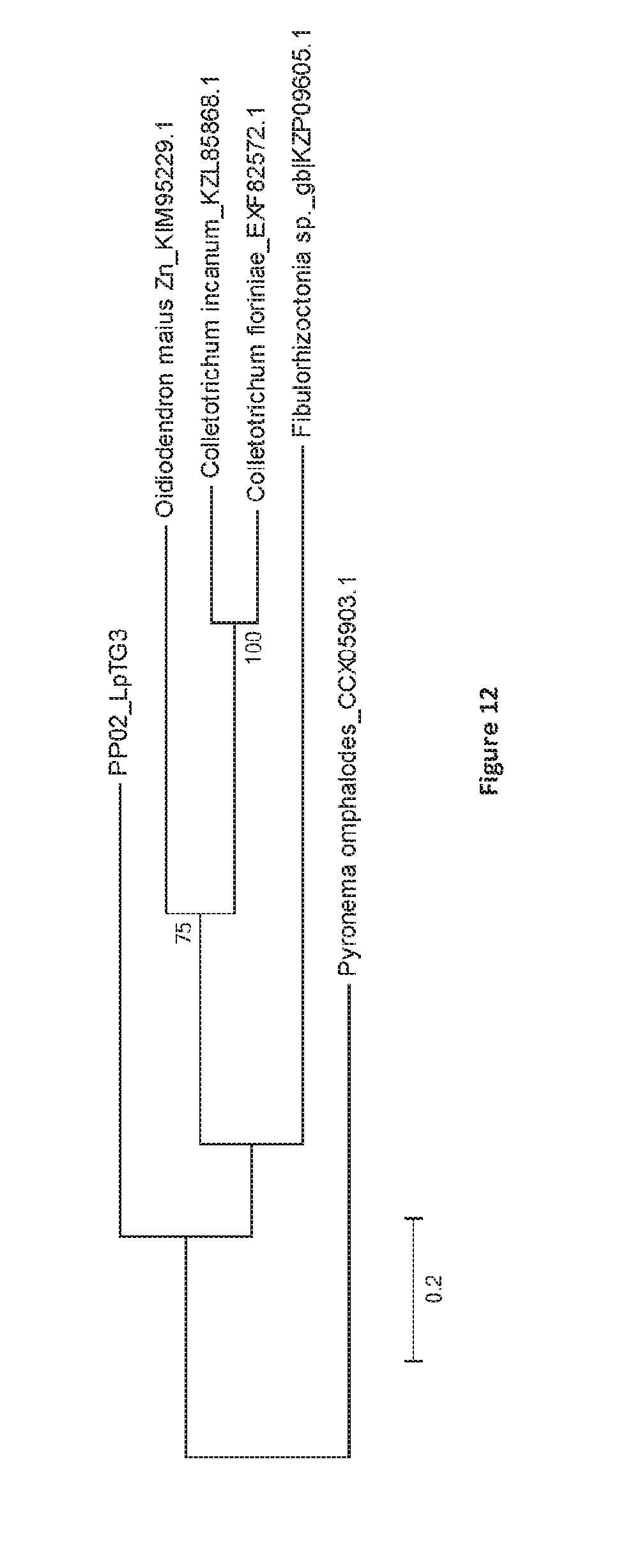
D00013
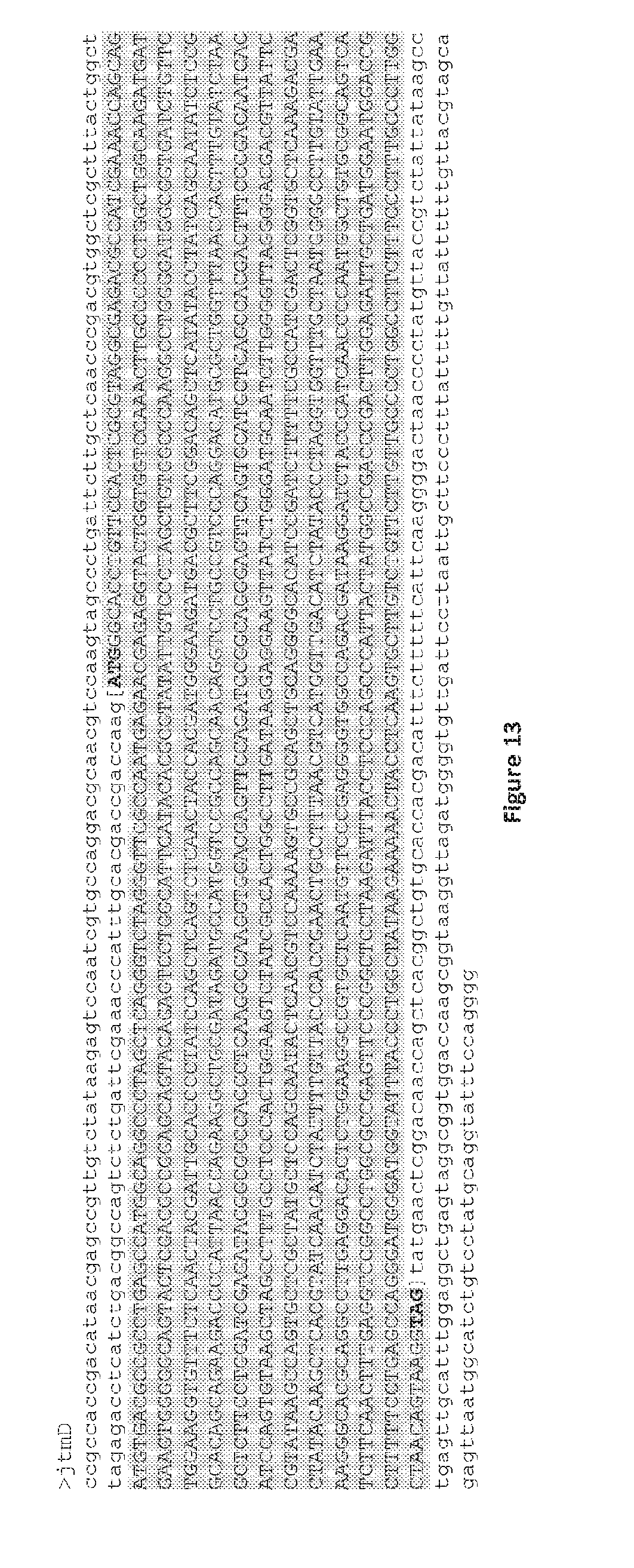
D00014
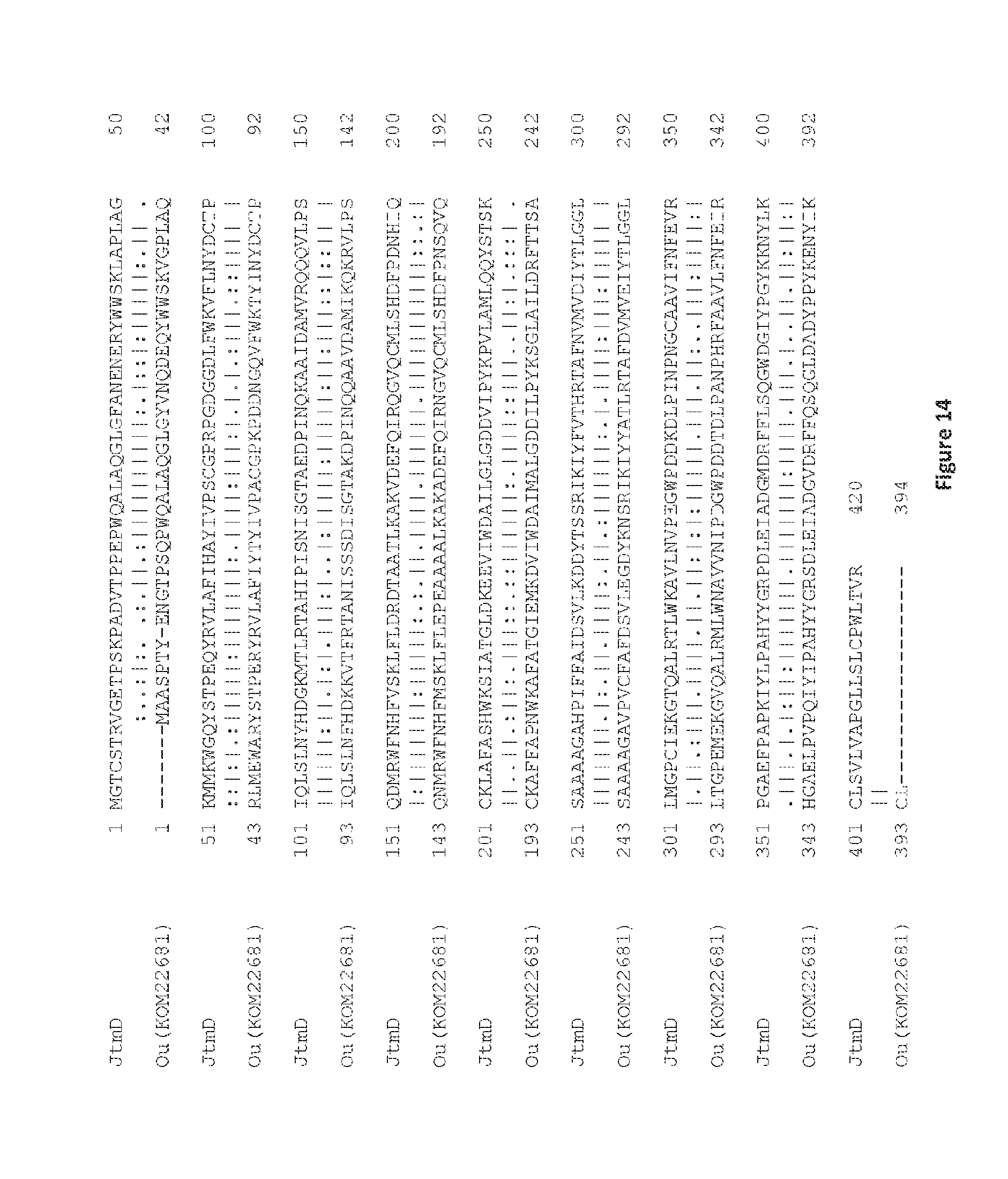
D00015
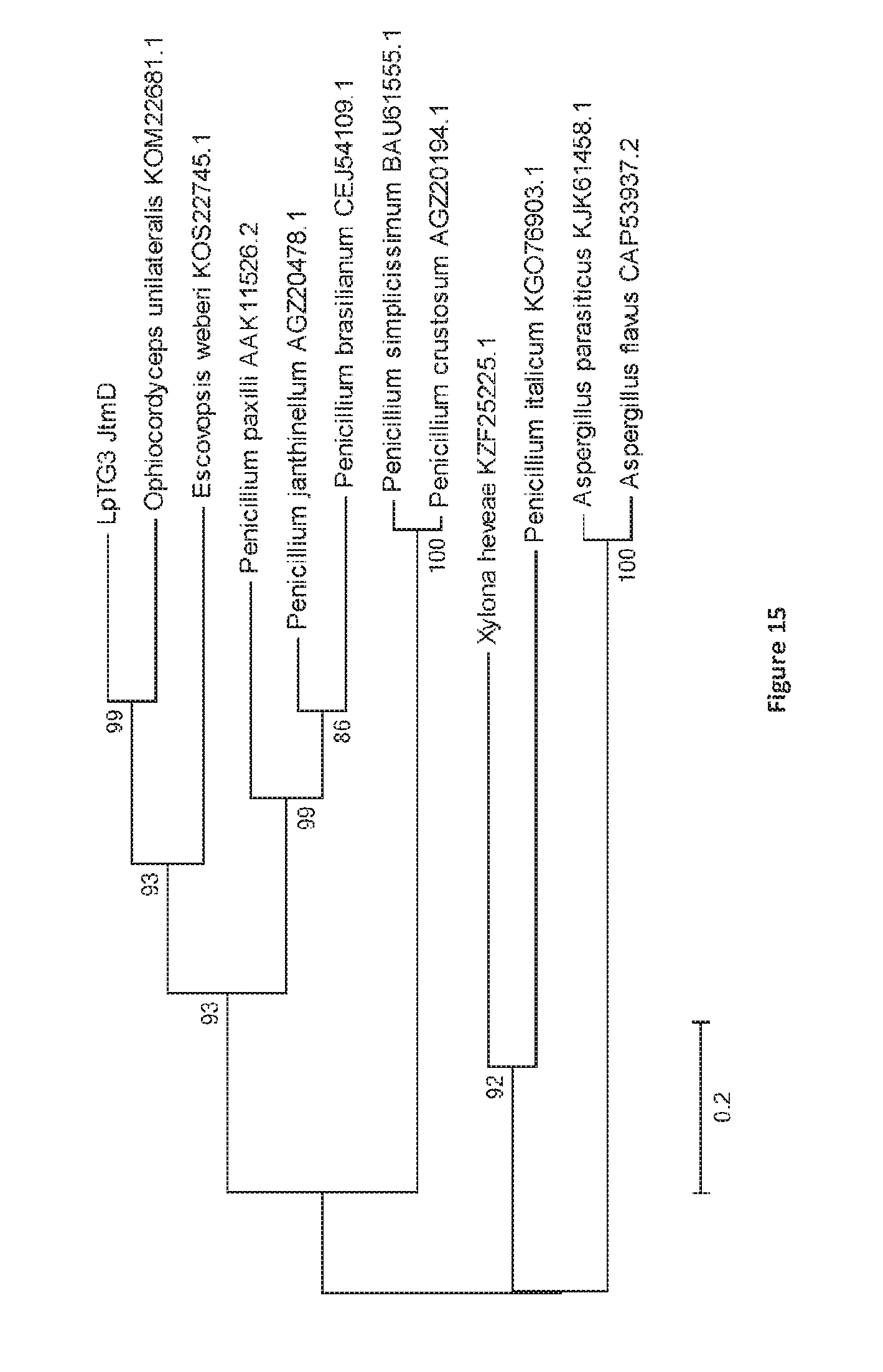
D00016
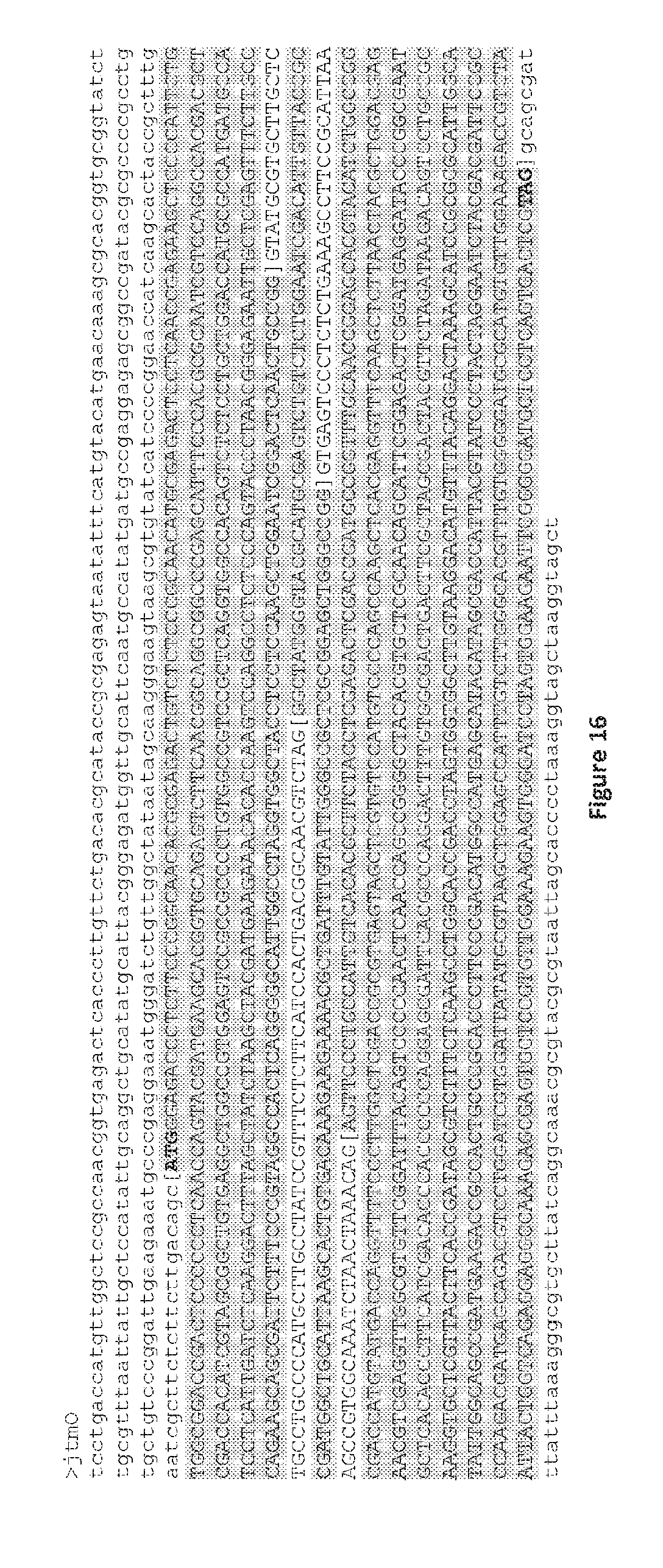
D00017
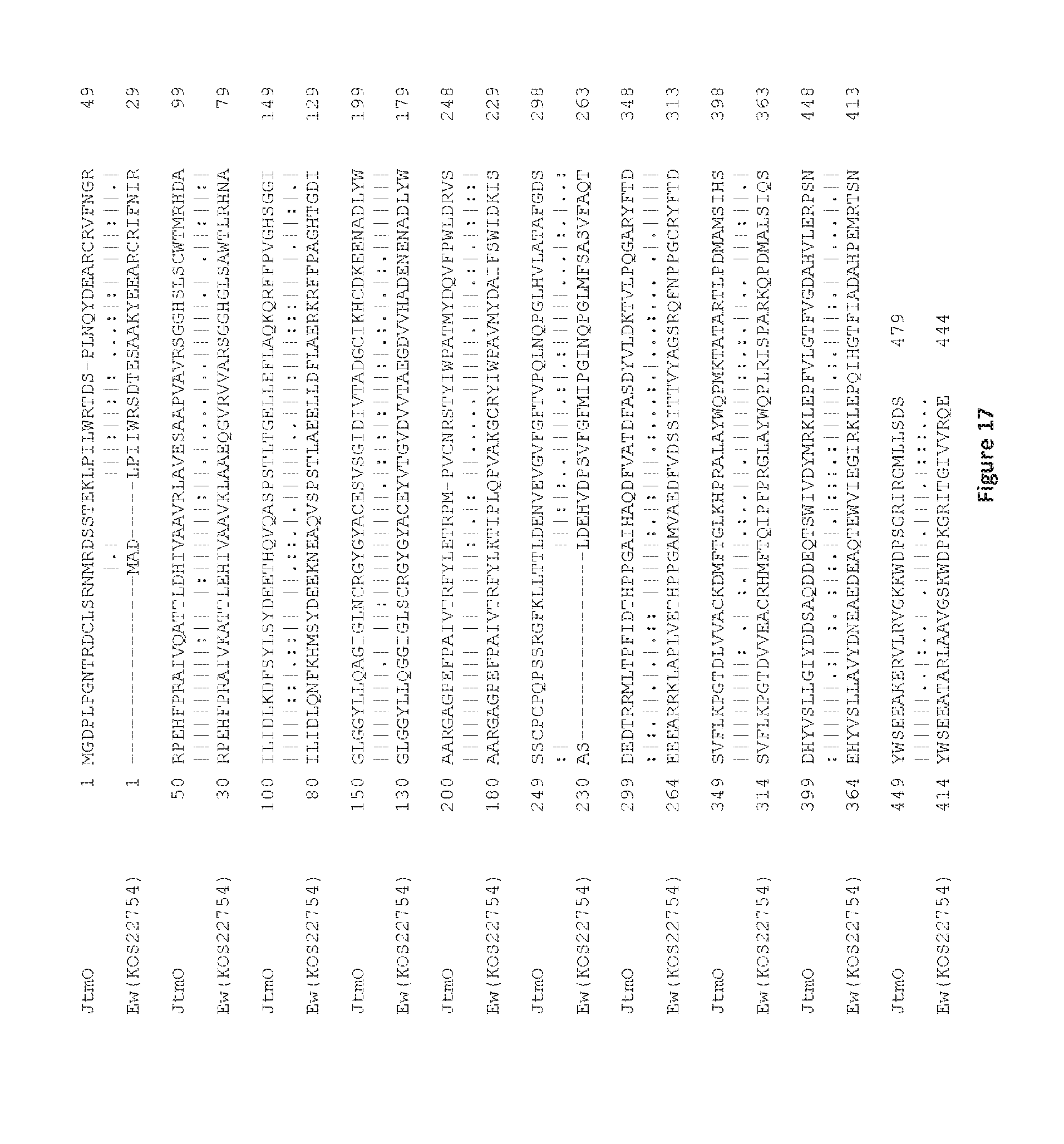
D00018

D00019
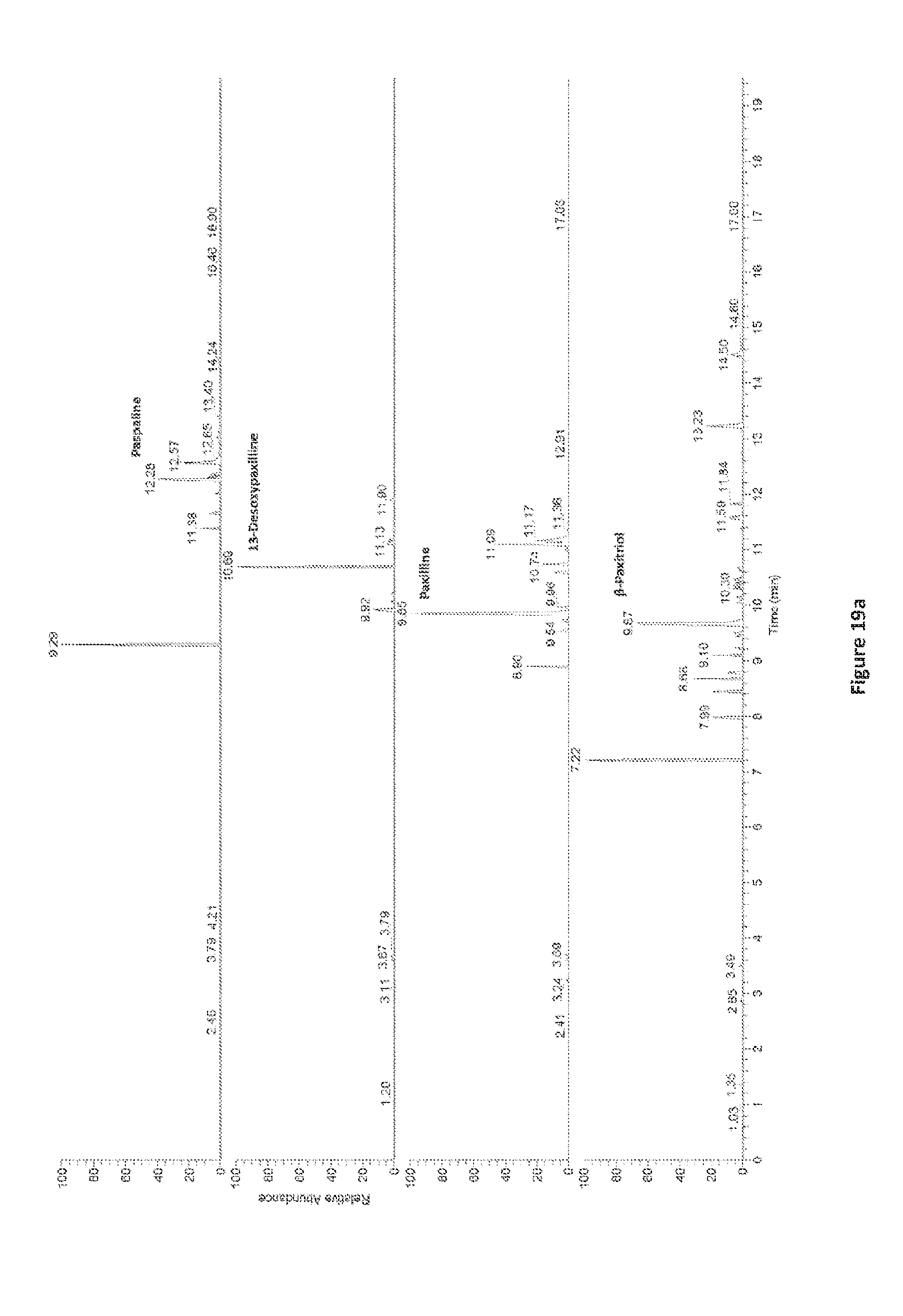
D00020

D00021
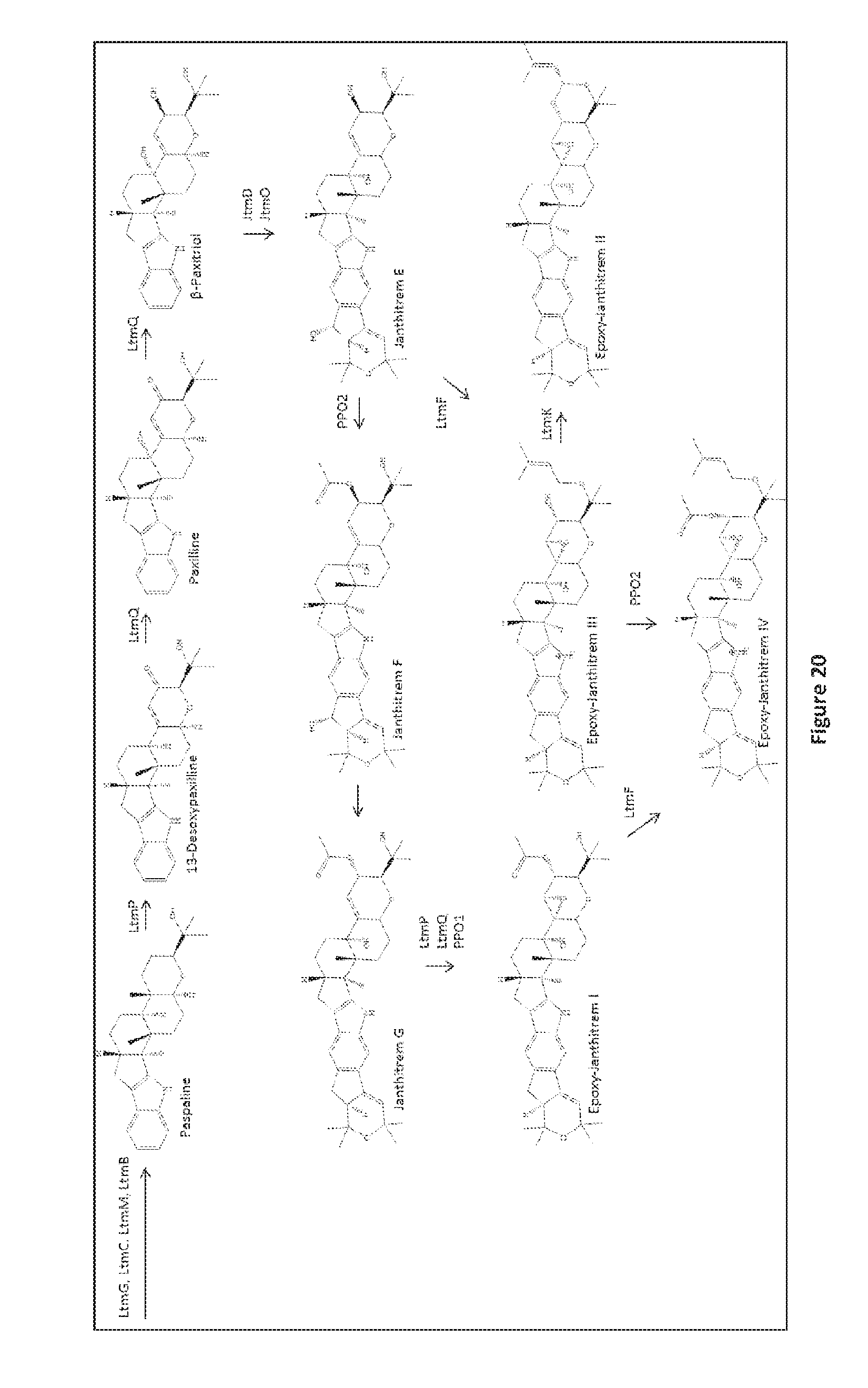
D00022
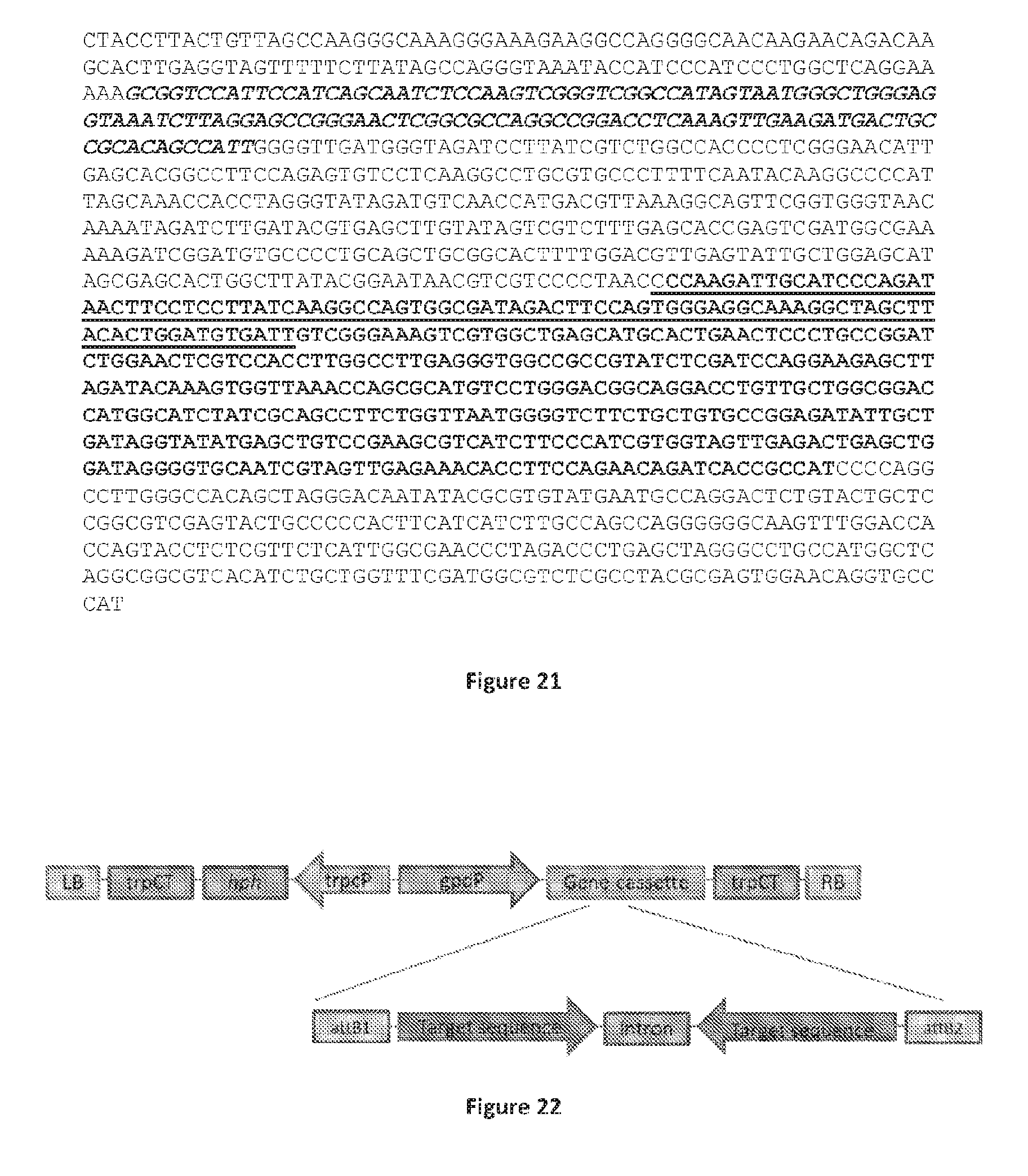
D00023
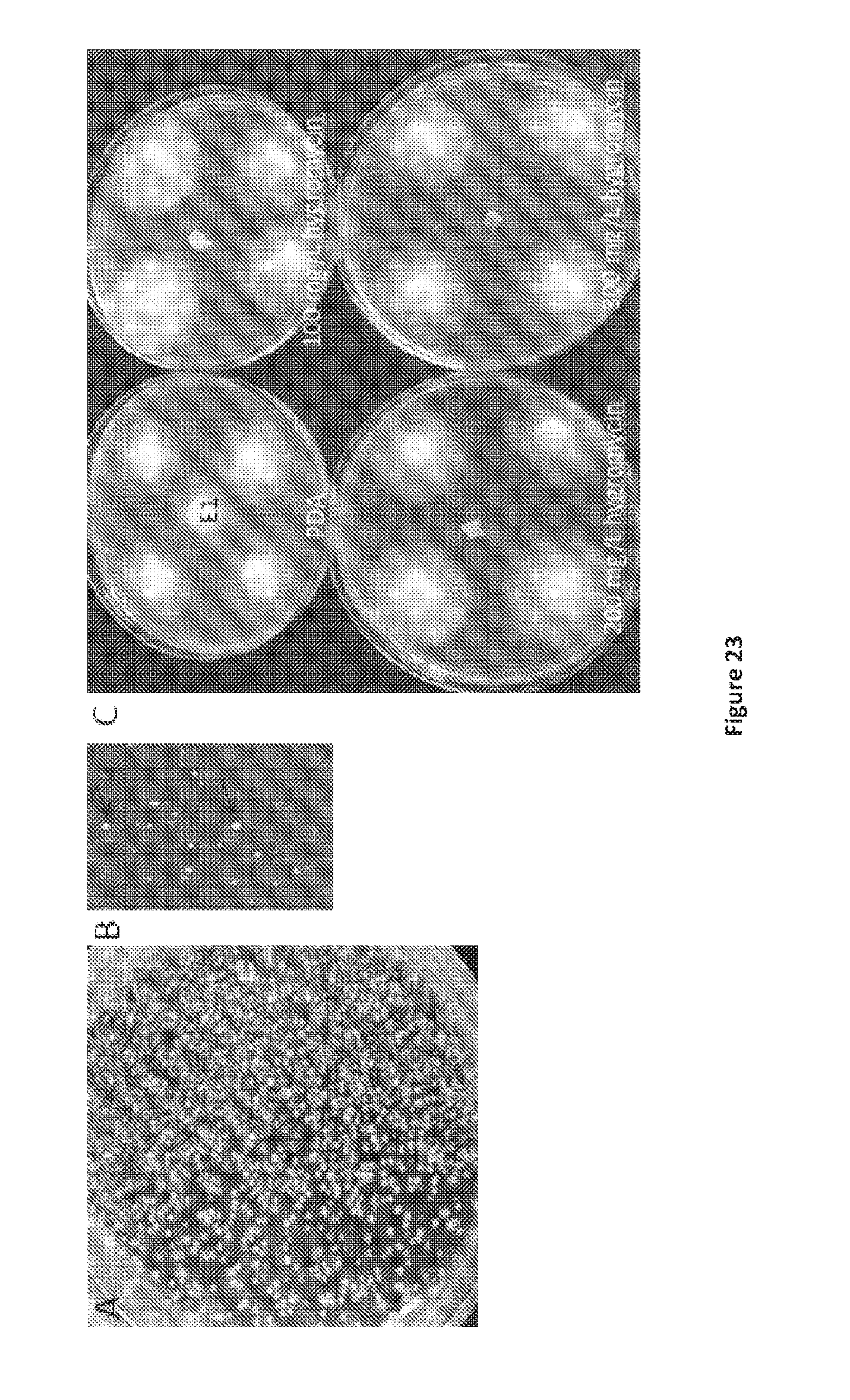
S00001
XML
uspto.report is an independent third-party trademark research tool that is not affiliated, endorsed, or sponsored by the United States Patent and Trademark Office (USPTO) or any other governmental organization. The information provided by uspto.report is based on publicly available data at the time of writing and is intended for informational purposes only.
While we strive to provide accurate and up-to-date information, we do not guarantee the accuracy, completeness, reliability, or suitability of the information displayed on this site. The use of this site is at your own risk. Any reliance you place on such information is therefore strictly at your own risk.
All official trademark data, including owner information, should be verified by visiting the official USPTO website at www.uspto.gov. This site is not intended to replace professional legal advice and should not be used as a substitute for consulting with a legal professional who is knowledgeable about trademark law.